Dragon’s Lair Trilogy: The Definitive Review (Complete 3 Game Review + Rankings)
January 1, 2023 3 Comments
2023 marks the 40th Anniversary of Dragon’s Lair, a pioneer of “more fun to watch than play” gaming. I was born in 1989, and while Dragon’s Lair II: Time Warp technically counts as “my lifetime” really, two-year-old me wasn’t playing anything besides peek-a-boo by that point. Fast forward to the 2000s, when we ended up owning Dragon’s Lair on DVD. “Have I got a game for you!” Dad said to teenage me. He threw it in and handed me the remote control (which was NOT a very good controller) and it was just about the worst thing I’d ever experienced in my life. Even Dad admitted that playing it with a DVD remote control was not the smartest idea. We tried it on a game console but it kept clicking-through to the DVD control menu. Fast forward to Christmas morning, 2010, and waiting for me under the Christmas tree, again from Dad, is Dragon’s Lair Trilogy for the Wii. The look on his face was so precious, a look that continued later in the day when I threw the disc in and proceeded to get totally demolished by the games.

Dragon’s Lair, Space Ace, and Dragon’s Lair II: Time Warp are games that never stood a chance against the test of time. They’re famous for three things: being beautiful to look at, being difficult, and barely qualifying as video games. They served as little more than novelties, or “attractions” for arcades. Well, Dragon’s Lair did. In my eleven years on social media, I have never once heard a single person trade a tale of Space Ace in arcades. Not once. On the other hand, I had one reader describe Dragon’s Lair’s reign as king of arcades like a bright, beautiful shooting star. Look away for a moment and you risk missing it completely, but if you saw it, you’ll never forget it. No game that has aged as badly is remembered so fondly by the generation that experienced it in-person in arcades. Sadly, it’s a phenomena I’ll never be able to fully understand no matter how hard I try. When Dragon’s Lair 3D: Return to the Lair released in 2002, to 13-year-old me, it was just another game, and not even a good one. The excitement of actually playing Dragon’s Lair was lost on me and my generation. A “you had to be there” we can’t understand.
Or, maybe not? The only way I can know for sure is to put these games through the wringer.

This is pretty much how my reviewing appears to developers.
Dragon’s Lair Trilogy retails for $19.99 on PlayStation, Nintendo Switch, and Xbox, with each individual game being sold separately on platforms like Steam for $9.99. Since that’s the sold-separately price, we’ll round it up and say a quality game in this set is worth $10 in value. I’ll round up the $19.99 price and say Dragon’s Lair Trilogy must get $20 in value to win my Seal of Approval. But, before I figure up the value of the games, I need to look at the slate of extra features in the set. Oh, before that, I have to mention the menus of Space Ace. Take a look at this screenshot from when you pause the game.

What option do you think is highlighted here? Believe it or not, “Continue” is the highlighted option, while nothing is highlighting the bright “quit” option that stands out a lot more in this screen. This is such a obviously bad choice that I’m convinced it’s an accident. That they MEANT for the brightened option to be the highlighted one, but whoever designed the menu accidentally crossed their 1s with their 0s and got it backwards. By the way, in every menu option where there is only two choices, this problem is there. Why not have an arrow? You know, that time-honored symbol you use to point at something and say THIS ONE! The other menus aren’t that much better. For Dragon’s Lair, is purple THIS ONE, or is it red? You would know from the front menu of the game since there’s more than two options to choose from and only one is a different color. But, if you weren’t paying that close of attention when you started the game, you wouldn’t know. Combined with the distinct lack of options for one of the extra features that I’ll get to and you can tell they just didn’t really care all much about presentation. I would have looked past it and just called this lazy, but then I keep going back to the gold/faded gold highlighting decision. I’ve been playing games my entire life and that’s the absolute worst menu select choice I’ve ever seen. I’m fining Dragon’s Lair Trilogy $5 in value for this. From here out, this will be the standard Definitive Review fine for bad menu design in classic game collections.
EMULATION EXTRAS
Dragon’s Lair Trilogy provides a few options for playing the games, though the one I wanted most is notably absent. You can choose three or five lives for each game. It really sucks that there’s no option for unlimited lives and a modern-style death counter for these games. There is every possibility that such an option might have made the difference between winning and losing. The lives system only makes sense if this is trying to suck money from players in $0.50 intervals. These days, the fun is in seeing how many times you croak before reaching the ending. It’s been years since this released, but if Digital Leisure wanted to attempt to appeal to modern gamers (and why wouldn’t they? We spend money too!), you don’t have to lower the difficulty. You just have to, you know, make it fun to die.
There’s also adjustable difficulty for the first Dragon’s Lair and Space Ace and a cabinet mode for all three games that I didn’t like one bit. Having played a lot of retro collections, there’s something about how this set handled scan lines on a TV screen that I found unconvincing. Dragon’s Lair allows you to play either the “Arcade” or “Home” versions. In the arcade version, you move to another screen if you die, whereas in the home version you have to repeat the stage until you complete it. Also included is a “Director’s Cut” option to play Dragon’s Lair II that changes the second-to-last level, making it shorter and nowhere near as memorable. I’ll talk about that more in the review of that game.
The most important addition is the “move guide” that you can optionally add to the bottom of every game. This is not the same as the flashing-light indicators the games originally utilized to guide your actions. It’s a directional overlay that tells you the exact button press, and you simply have to be quick on the draw. The cabinet mode also has lights that tell you which direction to press located around the joystick. Unless you have the games memorized, you basically have to play with either the move guide or the cabinet mode turned-on. Especially the first Dragon’s Lair and Space Ace. Take, for example, the very first scene in the entire game. Dirk falls through the rotten wood on the drawbridge and a monster pops out of the moat. You’re supposed to swing your sword at it, but the sword doesn’t flash yellow. You’re just supposed to know to use your sword, I guess. In fact, both Dragon’s Lair and Space Ace don’t always use the yellow indicators for both the action and the movement, and sometimes you just plain have to make an educated guess. By time Time Warp came around, they had included it with every move, but even with it, I found I couldn’t make progress at all without the move guide.
Of course, the downside is, they cover up the animation, which is the whole point of playing these. Instead of watching the whole screen, you’ll inevitably stare at the bottom of the screen waiting for the next prompt. I suppose you can think of this as a trainer to memorize which moves you do on what screen, but that’s assuming you actually want to get THAT good at forty-year-old games. Either way, the move guide is a welcome inclusion, but I’m not at all satisfied with the lack of options. Given how you can watch each scene bit by bit in the media extras, why not let people play and practice them? Why not have the option for a death-counter instead of lives? I would hope a modern re-release of a Dragon’s Lair collection (which would hopefully solve licensing issues and include more games) would do more in the future. As for this specific set, for all the emulation extras, I’m crediting no extra value to Dragon’s Lair Trilogy. If they gave you the option to replace the lives system with a death counter, I would award $5 in credit towards the set, and $2.50 for being able to practice individual scenes.
MEDIA EXTRAS

“The fish was about this big..” “That’s not how a big fish story is supposed to go, Rick!”
Dragon’s Lair Trilogy comes with a couple media extras, the highlight of which is an interview with Don Bluth, Gary Goldman, and Rick Dyer. It runs a little over twenty minutes and, if you’re a fan of this stuff like I am, it’ll leave you wanting a lot more. Not because this lacks the good stuff, but because the interview is so well done. Dyer especially comes across as a cool guy. The type of guy you want to see succeed. A mad scientist who, more or less, invented the FMV format as we think of it today. For better and for worse, I suppose. The problem with this interview is that there’s no option to rewind or fast forward. There’s volume issues, and if you mishear something, you have to restart the whole video and watch it again. That really sucks and I have to cut what I would reward this feature by half as a result. I wish it had been broken into separate segments. It makes no sense why they didn’t, especially since the actual feature does have title cards for each different part of the interview.
Dragon’s Lair Trilogy’s only other notable extra is a deleted scene for Dragon Lair II: Time Warp. It runs under a minute and is a partially voiced storyboard for a level set on a pirate ship, complete with what parts would flash yellow to indicate an action. The scene looks like it would have been dull. What’s frustrating is that the original Dragon’s Lair had many deleted scenes, including a full new “room” where one-eyed gargoyles hurl spears at Dirk. The scene is shown in the interview above, but you can’t watch it separately. Even more disheartening is the scene was apparently completed and colored by Digital Leisure, presumably with the intent of making it playable, but it’s nowhere to be found outside the interview. A quick glance at YouTube also makes it appear that there were multiple unused death animations that never made the game. It sure would have been swell to have all those. Space Ace gets no deleted scenes.

Dirk the Daring: the one hero in gaming who has irrefutable proof that he actually scootilypooped with the damsel he rescued. Of course, this leads into one of the great mysteries of video games: how the hell did Princess Daphne squirt out ten kids in what looks like a span of ten years and still maintain her figure? Clearly she messes around with the dark arts, which would explain why the forces of evil are always trying to kidnap her. They want to know her secret!
In fact, Space Ace feels pretty unloved by this set overall. Right before I finished this feature, I found out that a conversion kit for Dragon’s Lair II: Time Warp was created in 1991 that could turn it into a more difficult version of Space Ace that used diagonal moves. This is not included in this set. Space Ace’s only two “special features” are also included for the other two games: the attract screen and the ability to watch the full game without having to play it. That last one is the best feature, and it really says it all about this set, doesn’t it? That the best part about Dragon’s Lair Trilogy is the ability to just watch it without playing it.

They never mentioned which drugs produced the concept for Dragon’s Lair II.
Also, they got the three main guys behind the trilogy together to do a really good interview. Why stop there? DO AN AUDIO COMMENTARY!! Like, duh, right! Angela, future Spielberg of her generation, has helped me to rediscover the greatness of a well done feature film audio commentary. Dragon’s Lair and Space Ace especially could have benefited from hearing how game designer Dyer and animation expert Bluth came together to make one of the most famous games of all time. At one point in the interview, they touch upon how Bluth would interpret Dyer’s storyboards and create animation that didn’t work from a video game perspective (suddenly I have a hunch what went wrong with Dragon’s Lair II). Which scenes? In which ways? We don’t find out, and an audio commentary could have corrected this. Maybe we’ll get one eventually. Anyway, for all the media extras, I’m crediting $2.50 in value to Dragon’s Lair Trilogy. Had they offered more flexibility with how to watch the interview, I’d of called it $5.
THE ULTIMATE VERDICT ON THE COLLECTION
For those not familiar with my way of thinking of how retro games should be reviewed, I take NO historical context into account. I don’t care how important a game was to the industry, because that doesn’t make a game worth playing today. The test of time is the cruelest test of all, but every video game must face it. I might not be here if not for Space Invaders’ success, but I wouldn’t want to play it today. Not when there’s better options. Therefore, when I review retro games, every game gets either a YES! or a NO!
YES! means the game is still fun and has actual gameplay value when played today and is worth seeking out.
NO! means the game didn’t age gracefully enough to merit playing today and is not worth seeking out, and certainly not worth spending money on.
For Dragon’s Lair Trilogy, the final score was as follows:
YES!: 1 ($10 in Value)
NO!: 2
$2.50 in Extra Value
$5.00 in Fines
TARGET VALUE: $20
TOTAL VALUE: $7.50

Dragon’s Lair Trilogy does not earn my Seal of Approval. With only one game worth playing today, and a game that you can buy separately on a few platforms, it’s not worth buying the whole set. Frankly, I’m still stunned that I could give any game in Dragon’s Lair Trilogy a YES! at all. I had previously planned to have “I HATE FMV GAMES” etched on my tombstone. But really, there’s no reason to own all three games, one of which isn’t THAT bad but not good enough and one of which is one of the worst coin-ops ever made. I suppose you can still feel free to grab this set REALLY cheap. Like, under $10 cheap. Even then, I’m sure you can get Dragon’s Lair by itself even cheaper.
GAME REVIEWS
 Dragon’s Lair
Dragon’s Lair
Released June 19, 1983
Designed by Rick Dyer
Directed by Don Bluth

One of the problems with adapting Dragon’s Lair today, in the 2020s, is people would have a cow about a character like Princess Daphne. As if friendly but vapid airheads don’t exist anymore. Or perhaps they wouldn’t if not for portrayals in media, like this? I think that’s the argument. Frankly, I don’t care. Besides, Dirk himself is completely brain dead too. They are gaming’s most fit couple.
Man, did I ever get it wrong about Dragon’s Lair. I got fixated on the whole “it’s really just playing Simon Says with animated cues” aspect. Which, by the way, is still there. As far as elephants in the room go, this is an especially large one that’ll always be around, like a photo-bombing woolly mammoth. But, when you really stop and look at the set pieces and the timing and themes of Dragon’s Lair, you realize that, more than any FMV game ever made, Dragon’s Lair succeeds at creating the illusion of video game-like interactivity. Not only that, but it does so in a way that is practically clairvoyant. That read the tea leaves flawlessly on where video games would go eventually. It’s ironic that the sequel is called Time Warp, when really, it was the original game that saw the future. The type of boss fights and challenges in games that didn’t exist in 1983 but do now. Come to think of it, many were probably inspired by this!

I think one of the aspects that makes Dragon’s Lair stand out is literally every single character is memorable. It’s such a shame that nobody has managed to make a truly great game based on this franchise in the forty years since the original. All the pieces are certainly in place.
You can’t talk about any of these games without talking about the Don Bluth animation. Before we start, I want to qualify myself: I am NOT an expert at animation. I just watch a lot of it. People talk about Dragon’s Lair like it’s right up there with The Secret of NIMH or An American Tail or The Land Before Time. But, it’s actually not that high of quality. It’s somewhere between a really expensive Saturday morning cartoon and a feature film. Whenever a corner could be cut, chances are it probably was. There’s a lot of reused animation throughout the game. People, including myself, overlook that, but when you’re paying attention, they stand out. Space Ace is worse about it, but it’s there throughout Dragon’s Lair. On the other hand, I love the use of color and I think the backgrounds are just beautiful. I think they went a long ways towards making Dragon’s Lair work. It feels like an adventure because it looks like one.

The later Dragon’s Lair 3D tried to recreate set pieces like this to various success. Had Dragon’s Lair 3D featured the smooth controls and lightning-fast responsiveness of a game like Prince of Persia: Sands of Time, for all we know, it might have gone down as one of the all-time greats. But, Dragon’s Lair 3D had sluggish controls, a problematic camera, and this RIDICULOUS recoil whenever you ran into a wall or object. AND YET, it still managed to be just a little bit alright, but nothing special. For a game with that many problems to still step across the “alright” threshold makes me wonder what if? about it. What if it had good play control and didn’t have that absolutely stupid recoil? Would it have been an unprecedented hit and reignited the franchise? We’ll never know, I suppose. I’m sure eventually they’ll re-release it, but I hope they don’t in its present state. Dragon’s Lair 3D turned twenty-years-old in November, and gaming has come a long ways. Scrap it and go again with modern technology and maybe, at long last, Dragon’s Lair will be the franchise it deserves to be.
Having said all that, I think the understated part of what makes Dragon’s Lair work, besides the beautiful use of color and the striking backgrounds, is that every room creates the illusion of an interactive video game. The last third of Space Ace and pretty-much all of Dragon’s Lair II come across like watching a movie that someone shoehorned button prompts into. That happens in Dragon’s Lair too, but it’s most rare in this game. The rooms are designed like video game challenges. Swinging left to right (or right to left if the room is mirrored) across flaming ropes. Dodging giant, rolling balls that are set to a pattern. You’re always acutely aware you’re not really controlling Dirk the Daring, but Dyer and Bluth did everything in their power to suspend your disbelief anyway. They even manage to succeed in some rooms, where the framing and directional options are unambiguous: the challenge is right, so move left. The beast is coming at you, so use your sword. It takes proper staging to pull off, but sometimes they did, and suddenly, Dragon’s Lair ain’t too bad a game at all.

The rafting sequence is one such area. The timing of when to press the prompts and the various hazards that take place during this sequence just plain work as a magic trick that makes you feel like you’re in control of an already animated cartoon. I love using the magic trick analogy with Dragon’s Lair, because you never forget what you’re doing isn’t real. It’s not immersive at all. Instead, it becomes okay to allow yourself to play along anyway. That’s what makes stage magic fun, and Dragon’s Lair is basically stage magic as a video game. We know the score, but we’ll pretend we don’t, because we want to have fun.
Dragon’s Lair has more moments like that than any FMV game I’ve ever played. But, that doesn’t always mean the results work. Some of the rooms don’t do enough visual cues to make it predictable what the move will be. Moments where, logically you would think you’re going to press one direction, but really, you’re supposed to press another. Take this moment:

Assuming you weren’t using the move guide, which tells exactly when to press a button and what to press, what way would you press in the above screen shot? The flashing thing is to the left of you, but also in front of you. Hell, in theory, it’s also lower than you, would could imply you have to jump downward towards it, right? Well, the correct answer is you’re supposed to press UP. Even though the flashing target is in the lower left hand of the screen. I can’t imagine how many quarters a person would have needed in 1983 to commit this to memory. One reoccurring story I keep hearing from people is gathering around to watch someone in an arcade who could run through the entire game effortlessly. I’d not had the patience to get that far at all. I did make a good faith effort to play without the guide, but I couldn’t figure out what moves to do, and frankly I didn’t have any fun trying to figure it out.

In some areas, there’s no way to anticipate what move could possibly be the next move. You have to wait for a cue, or just watch the guide. Well, at least with Dragon’s Lair, I found I could do both.
Oddly, Dragon’s Lair is the only game in the trilogy where you can play with the guide on and still watch the cartoon too. It’s not a visually complex story. There’s not a lot of screen clutter. You don’t have dozens of moving objects, or even if you do, they’re staged correctly to not distract from the point of PLAYING the game. It’s a “clean” presentation that remembered what it’s asking of players: enjoy the show, but also do things based on what the show does. That’s why Dragon’s Lair succeeds even forty years later while Space Ace and especially Dragon’s Lair II: Time Warp crash and burn. It IS an interactive movie, like few attempts at such a thing have been able to pull off. Even with the guide, you won’t miss anything with Dragon’s Lair. It’s something I didn’t appreciate until I played the other two games. How I tested this is I replayed each game a third time in three days and had my father and sister quiz me on details of the games. NOTHING unfair, and they understood what I was aiming for and went for details anyone playing the game should notice. For Dragon’s Lair, I answered six out of seven questions correct. For Dragon’s Lair II, it was two out of seven. For Space Ace, it was only one out of seven, with the one that I got right being from early in the game.

This memorable scene is an example of “this would be so cool if you could actually play it!” that certainly was NOT cool to play when you really could in Dragon’s Lair 3D. And actually, the scene is a little overrated in the arcade game. The patterns the knight taps out on the floor don’t always seem to make logical sense in terms of which button you’re expected to press.
Let me be clear: Dragon’s Lair isn’t a great game by any stretch. Besides the occasional “why would you press that direction at that moment?” issues, the game also makes you eventually repeat each room, only with the animation mirrored so every left/right move is reversed. Of course, if they didn’t do this, a game of Dragon’s Lair would only take about six minutes to complete. The biggest knock I have is against the historically terrible finale sequence. The rooms are all relatively short, which serve as logical checkpoints if you lose a life. In fact, I consider the smallness of the rooms to be a highlight of the game. It makes it feel like a real castle you’re exploring.

That’s probably the most underrated aspect of what makes Dragon’s Lair work: some rooms can be as short as one action. None of that minute-and-thirty-second short film that you have to replay over and over crap from the sequel.
Except for the final room with Singe the Dragon, which has no checkpoints, and the game grinds to halt and becomes agony. First, Singe nearly wakes from his sleep, which takes a while of just waiting around and doing nothing. AND THEN, FOR NO REASON, Princess Daphne very slowly explains that you need to retrieve a magic sword that’s in the room and use it to get the key around Singe’s neck. And she’s doing stripper poses the entire spiel. Mind you, this explanation was totally unnecessary. If it was a new and unique gameplay method, FINE, but it wasn’t, so what the hell were they thinking? You’re not doing anything different than you were doing leading up to this. You’re still just pressing buttons based on prompts. If you die.. and you probably will since the timing of this room can be brutal.. you have to watch this whole sequence again, from Singe’s nearly waking up to Daphne’s striptease-instructional video. No means to skip it. It’s torturous to sit through even once since a game about constant acton-reaction now suddenly has you just standing around waiting for the game part to start again. AND YOU HAVE TO REWATCH IT EVERY TIME YOU DIE! I get they probably wanted this room to feel climatic, but when you’re playing a game called DRAGON’S Lair and you slay a dragon and rescue the girl, that ought to be climatic enough. It’s one of the worst finales to a game I’ve ever seen. It ain’t a deal breaker, but it almost was. I had to think about it.

I actually didn’t kill Singe here. He died of old age after hearing the unskippable dialog for the three-dozenth time.
Okay, so Dragon’s Lair didn’t exactly stick the landing in its final act. But, everything up to that point is a lot better than I’ve ever given it credit for. It’s not fantastic or anything, but I enjoyed my time with it. Just think, all it took was basically creating the perfect FMV game to get me to finally say YES! to one of these things. And yet, I still wasn’t sure why the generation before me holds this up so fondly. Why they still get starry-eyed as they share tales of epic failure and sessions that lasted under a minute, or gathering around to watch that one weirdo who blew his life savings memorizing every sequence. Despite its relatively short window of fame, brutal difficulty, and all the truly-awful games in the franchise that followed, Dragon’s Lair is still is a game you want to enjoy. Why is that? I have to believe it’s for more than just the Don Bluth animation, or the hilarious yelps and squeals of Dirk the Daring, or what is just alright gameplay that is ultimately probably the best the format is capable of. So, I again asked myself: what could have possibly made those memories of Dragon’s Lair echo so loudly across the decades?

These two would go on to have ten kids.
I think I have the answer. Because the set pieces and art and characters all came together to make what players in 1983 wanted games to be like, but they weren’t. Not yet. Although it wasn’t their intention, Dragon’s Lair feels like a promise to gamers: this is where the medium is going. One day, games will look and sound this good and have action this exciting, only it will be you in control. Well, we all know what happened over the next forty years. Dragon’s Lair survives through history because it represents the promise of gaming kept.
Verdict: YES! **FLIP**
 Dragon’s Lair II: Time Warp
Dragon’s Lair II: Time Warp
Released June 16, 1991
Designed by Rick Dyer
Directed by Don Bluth

Pictured: Cathy’s brain melting from peeling back all the layers of awfulness from Dragon’s Lair II: Time Warp.
If I was too hard on Dragon’s Lair before, I wasn’t hard enough on Dragon’s Lair II: Time Warp. Talk about losing the plot! This sequel forgot literally everything that made the original game (and some of Space Ace) work. Dragon’s Lair, for all of its FMV-based flaws, still does everything in its power to look like a video game adventure. Time Warp doesn’t at all. It’s a series of disconnected animated vignettes that completely fails in every imaginable way. In the annals of bad games, it’s astonishing that nobody ever brings this one up. Perhaps because it’s an FMV game and that’s too low of a low-hanging fruit. Perhaps because the Don Bluth animation is so beautiful and vibrant. Perhaps because the nine segments of the game are so memorably bonkers that you wonder if the game was co-written by cocaine. But, actually playing Dragon’s Lair II, it’s shocking how many different ways a simple FMV sequel to the FMV game of the Golden Age could be so bad. How it could get it so wrong?

Time Warp starts off with Dirk’s mother-in-law trying to murder the man who rescued her daughter in the first place and is likely the only person capable of rescuing her again. In terms of intelligence, the apple fell about two inches from the tree on that one.
The most obvious problem with Dragon’s Lair II: Time Warp is that this really doesn’t make any effort at all to feel like a video game. In Dragon’s Lair, the game randomized all but the first and last levels of the game. It worked there because they were all short and they all flowed seamlessly into each-other. Time Warp’s nine levels are longer, linear, and with the exception of the first level, have no checkpoints at all. They’re also all, more or less, self-contained animated shorts that don’t fit-in with each-other. The moments where it feels like they were trying to animate some form of a video game trope in order to invoke the expectations of what a game should be like are few and far between. In Dragon’s Lair or Space Ace, whether you were swinging across ropes, timing when to move between spikes, leaping across platforms, or fighting monsters, the designers created the illusion that you were controlling Dirk and Dexter (well, until they forgot to do that in Space Ace too). Time Warp feels like a totally disconnected animated short that someone surgically grafted button prompts onto.

This is Eve. As in Adam & Eve. As in the Garden of Eden, which is the fourth stage of the game. Whereas Dragon’s Lair felt like an actual video game where a knight searches a castle looking for a damsel in distress, Time Warp feels like a series of two-minute-long Silly Symphony clips that someone attached a video game to long after the fact. Which isn’t far off from the truth. The Alice in Wonderland sequence for Dragon’s Lair II debuted on television in 1984 and the game was apparently fully completed between 1984 and 1986. It never came out until 1991 thanks to the bankruptcy of Cinematronics.
They must have realized how poorly flowing this would work as a video game, so in Time Warp, every single move does the yellow flashing prompt. You’d think that would make this the most playable game, but often the actions are too brief and the visuals so loud that you might need a couple lives to see them. Of course, every time you die on a stage, even if it’s the very last move on that level before you finish it, you have to start all the way over at the beginning. These aren’t teeny tiny rooms, like in Dragon’s Lair. These levels last over a minute of basically non-stop quick-time events where one mistake means you have to start over from the beginning. What’s especially annoying is they seem to have animated each level with moments that were clearly meant to be checkpoints. In the first level, you go from being chased by your mother-in-law into entering the castle from the original game, and if you die after the dungeon, you restart from there. Makes sense! Well, even though there’s a moment like that in each of the animated segments that follows, like a turning point in the action, it’s not utilized and you have to start over if you die.

Dragon’s Lair has lots of beautiful art, but it also remembers that players are focused on the game itself. All the stuff happening on the screen is done in service to the gameplay. Dragon’s Lair II is filled with sight-gags and small details that you will die if you watch, because you’re not focusing on the next button prompt. I’m sure this was done in service to the days where people would gather around and watch someone play the game, but it’s a game that constantly forgets it’s game.
It stinks of game has no interest in giving players value. Instead, Dragon’s Lair II is completely focused on trying to squeeze as many quarters as possible. But, if you thought the lack of checkpoints was greedy, you ain’t seen nothing yet. Dragon’s Lair II: Time Warp gates players out of the final two levels unless they find all eleven magical items that are hidden throughout the first seven stages. It’s a sleazy move that made me feel unclean as I played it. Imagine playing through this in an arcade in 1991 and being interested in it enough that you spend enough money to GIT GUD and make it past the Ancient Egyptian level (ironically the only level in the entire game that feels remotely like the first game), and then suddenly the game just restarts from the beginning because you didn’t gather all items. In a game where you have a single second to make a decision, and ten times it will flash in two directions at once because one of the choices has the item, and you have to choose correctly, going ten for eleven, or else you.. keep going but actually will now have to replay the whole game from scratch eventually too. What a load of crap. Also, yes, ten times. For the playing card in stage three, they didn’t bother to animate the indicator that it’s one of the items you must get. Even worse: because of the Alice in Wonderland theme of that level, you wouldn’t even think that it’s THE item. It’s just right there and blended seamlessly with the rest of the design. Actually, some of the items that do flash do so in very visually-loud sections. The butterfly in the Beethoven stage is practically invisible!
I should also note that the arcade game had a scoring system that was removed completely from the home version. I didn’t even know that until I started researching whether the arcade game actually told players anywhere that they HAD to get the treasures to finish the game. It does.. at the bottom of a three-second long instruction screen that is briefly seen during the extended attract mode that runs on an over one-minute long cycle. It’s shamefully greedy on the same level that Ghosts ‘n Goblins forced full-replay was. Even worse: logically the way to not screw players is to make them only replay the levels where they missed an item, right? Well, Dragon Lair II has contempt for its players, so you have to replay the whole game from the start. Wow. Leland Corporation’s bankruptcy was well-deserved after pulling crap like that, and good riddance.

The best scene in the entire game is the eighth level, where Mordroc actually gets the Death Ring on Princess Daphne, who turns into Ganon if Ganon were a drag queen. BUT, if you play the Director’s Cut, this never happens. It starts exactly the same, with Mordroc clearly putting the Death Ring on Daphne and Dirk throwing his sword through his arm. Then, the scene changes from the original, and suddenly Daphne is out of the shot and the Death Ring isn’t on her. In a shorter, more plodding and less fun scene, you dodge Mordroc’s attacks before knocking the ring onto his finger. The one good call this game made was going with the Monster Daphne sequence. Too bad everything leading up to it was an unprecedented disaster.
So, that’s Dragon’s Lair II: Time Warp. I have nothing positive to say about it as a game. Dragon’s Lair wanted you to feel like you were in control of Dirk. Dragon’s Lair II feels like it wants you to appreciate the amazing art of Don Bluth while it shakes you down for quarters. We can do that without this button prompt stuff or the schoolyard bully robbing you of your lunch money routine this game pulls. The on-screen action feels completely disconnected from the controller. The item collecting system and lack of checkpoints practically makes Dragon’s Lair II a mugging. It’s astonishing to me that the same people who crapped all over the Sega CD’s Mighty Morphin Power Rangers game for having absolutely nothing to do with the on-screen prompts rewarded Dragon’s Lair II with raving reviews when it did the exact same thing. If you want to know whether a game critic is shallow or not, see if they did a review of Dragon’s Lair II, and if they did, see how much they focused on the incredible art work and not on how it factors into video game logic. Because this is BAD. As in I literally can’t believe nobody brought this stuff up in 1991. Dragon’s Lair II: Time Warp should be listed among the worst arcade games ever made. Sure is pretty, though.
Verdict: NO!
 Space Ace
Space Ace
Released December 21, 1983
Designed by Rick Dyer
Directed by Don Bluth
I spent the last three days going back and forth on whether Space Ace would get a YES! or a NO! On one hand, I think it’s the most beautiful game in the trilogy, with a fun theme, an awesome concept, and a white-knuckle pace. On the other hand, like Dragon’s Lair II, it forgets it’s a video game and not an animated short about two-thirds of the way through it. It’s also the most frustrating from a technical point of view, as with-or-without the move guide, the timing of Space Ace in certain aspects feels like it genuinely isn’t lined-up properly with the on-screen action. This game was rushed through production, and it shows.

Fun Fact: Don Bluth himself provides the voice of both the villainous Borf and Dark Dexter, while animator Will Finn (who later worked for Disney during the 90s on basically every one of their good movies from that time period) provides the voice of Ace. I’ve been playing video games my entire life and, trust me, I know how bad things can be when developers grab whoever is handy, be it Sally in Accounting or John from Human Resources to do voice work. For someone who is NOT a professional voice actor by trade, Finn does a dang good job voicing Dexter. I’d genuinely never guessed this wasn’t his actual profession.
As always, the animation is jaw-dropping gorgeous, and the characters are memorable. The story and gameplay also have a tiny bit more going for them. The heroic dude-bro Dexter, aka Space Ace, is emasculated by the villainous Borf and turned into a pathetic weakling. Borf then kidnaps Kimberly and you must go on a daring adventure to rescue her. The twist is that sometimes you can “energize” and turn back into the big, buff, cocky Ace. There are times where, if you don’t do this, you die. But, most of the time, energizing branches the game into different types of sequences. There’s also a lot more “choose a random direction” moments, but since you’ll have to play out every scene anyway, there’s no point in having these. It only creates the illusion of unseen areas. It’s fine, but the problem is that Space Ace doesn’t put it all together properly and sort of ruins the whole experience in the process.

When Space Ace tries to invoke video game tropes like patterns and timing, it might actually be better than Dragon’s Lair. Take this scene in the first “level.” I mean.. look at that! That looks exactly like something you would see in a video game, right? A 2D timing challenge. If you’re going to do a fully-animated FMV video game that aspires to create the illusion that you’re actually controlling the character, yep, that’s the way to do it. But, at some point, it forgot to do these parts.
Like Dragon’s Lair, you have to repeat every major set piece and room once. But, unlike Dragon’s Lair, instead of mixing up the order, in Space Ace (at least on the highest difficulty setting), every sequence that repeats is done back-to-back. You play a room once, and then the screen goes black for a split-second and then it just repeats, only mirrored. It’s so lazy and jarring and it takes the wind right out of Space Ace’s sails. I cringed every single time it happened. Honestly, in Dragon’s Lair, I came to appreciate the mirrored levels. “Alright, I’ve done this room! What was the order?” I’d ask myself. That excitement wasn’t there for Space Ace because I literally just did this section. And, unlike Dragon’s Lair, which is set in a castle that would have many rooms, in Space Ace the narrative doesn’t lend itself at all to the repeating rooms. Not one bit. It’s Dexter running down an identical corridor, begin caught in an identical plastic bag, energizing at the exact same moment with the exact same pose.. it’s just so badly done. Not even comically bad, but just sadly bad.

The flashing that was used in Dragon’s Lair and especially Dragon’s Lair II occasionally happens in Space Ace, but sometimes it doesn’t. Like right here, it doesn’t at all. I can’t imagine playing without the move guide, where the timing is totally guess work. In fact, I’ve heard Space Ace machines had the joysticks wear out a lot from people slamming them in the direction repeatedly. If you were wondering, here you would press LEFT.
And then you get to the areas where the on-screen action stops feeling like a video game and starts feeling like an animated short that someone just super-glued button prompts onto. This is the game I could make the least progress on without the guide. The game just plain quits helping sometimes, and guessing which direction was the correct direction, or WHEN to press the buttons for that matter, was purely luck-based. But, even when the indicator lights do flash, at some point a clear disconnect between controller actions and story narrative happens. The motorcycle sequence and the battle with Borf feel like just an ordinary cartoon that you have to press a button every couple seconds to make play. It’s no longer directed like a video game. It’s just a cartoon by that point. Which.. I guess that’s what all three of these games are, but what I mean is that it no longer feels like you’re playing Space Ace. You’re just advancing it.

The end sequence sealed the NO! for this one. As an animated short, it’s satisfying, but as a video game, it’s a bit of a nonsensical disaster.
To Space Ace’s credit, it provided one final gaming highlight for me in 2022. I’d partially written these reviews for an abandoned article in 2021, and I needed to replay the games just to make sure I could. With my reaction time fading, it was basically now-or-never for this feature. While playing Space Ace, I game overed fairly quickly. Well, it turned out to be my only game over. To my absolute shock, I ran the table from there, losing a couple lives but still beating the game without needing another continue. What the fudge? ME? Are you kidding me? That felt really amazing. No joke. The lives I lost were of the “something about the button timing and the animation doesn’t seem to match-up at all” variety, but I didn’t mess-up after that. It felt great!

By the way, there’s both a Dragon’s Lair and Space Ace animated series by Ruby-Spears. In the Space Ace cartoon, which unlike Dragon’s Lair was done as part of the Saturday Supercade lineup, Kimberly is voiced by Nancy “Bart Simpson” Cartwright. I tried to watch these cartoons but I found them to be poison for the brain.
On the other hand, I pulled this monster final score off by not even watching the cartoon at all and instead focusing completely on the move guide. That’s what ulimately made the difference with these two games. With Dragon’s Lair, you can both enjoy the spectacle and play the game at the same time. It’s not a visually busy game. Space Ace always has a LOT going on, and if you take even a microsecond to appreciate that, you might find yourself losing a life. And now, it makes sense why nobody trades tales of Space Ace despite looking every bit as visually impressive as Dragon’s Lair. The fact that the first game proves you can get away with a visually nice animated game guided by a series of quick time events means I can’t excuse it for Space Ace. It needed to take a less-is-more approach, and it didn’t. Most telling of all: while I thought Dragon’s Lair II was more distracting, I actually scored lower on Space Ace in my quiz test. This was the game where Dyer and Booth lost their way.
Verdict: NO!
FINAL RANKINGS
How I determined the rankings is simple: I took the full list of games, then I said “I’m forced to play one game. Pick the one I could play the most and not get bored with.” That goes on top of the list. Then I repeat the question again with the remaining games over and over until the list is complete. Based on that simple criteria, here are the final rankings. Games above the Terminator Line received a YES! Games below it received a NO!
- Dragon’s Lair
**TERMINATOR LINE** - Space Ace
- Dragon’s Lair II: Time Warp

I seriously can’t believe I did that score though.








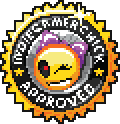 Garbage Pail Kids: Mad Mike and the Quest for Stale Gum is Chick-Approved
Garbage Pail Kids: Mad Mike and the Quest for Stale Gum is Chick-Approved Garbage Pail Kids: Mad Mike and the Quest for Stale Gum was developed by Retrotainment
Garbage Pail Kids: Mad Mike and the Quest for Stale Gum was developed by Retrotainment





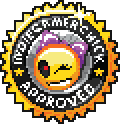 Teenage Mutant Ninja Turtles: The Cowabunga Collection is Chick-Approved. Having an official re-release of Turtles in Time for the SNES is a pretty amazing thing, but this collection has a few surprises as well. I didn’t expect to like the original arcade game, and in fact, I enjoyed my time with it a lot. I didn’t expect to like any of the Game Boy games, but two of them were acceptable time wasters. I certainly didn’t expect to enjoy the two hours I spent with Manhattan Project for the NES, yet here we are. Five totally solid Turtles games, emulated to perfection, plus a whole lot of bonus material, makes this a set worthy of purchase.
Teenage Mutant Ninja Turtles: The Cowabunga Collection is Chick-Approved. Having an official re-release of Turtles in Time for the SNES is a pretty amazing thing, but this collection has a few surprises as well. I didn’t expect to like the original arcade game, and in fact, I enjoyed my time with it a lot. I didn’t expect to like any of the Game Boy games, but two of them were acceptable time wasters. I certainly didn’t expect to enjoy the two hours I spent with Manhattan Project for the NES, yet here we are. Five totally solid Turtles games, emulated to perfection, plus a whole lot of bonus material, makes this a set worthy of purchase.






































 Return of the Obra Dinn is Chick-Approved
Return of the Obra Dinn is Chick-Approved Return of the Obra Dinn was developed by Lucas Pope
Return of the Obra Dinn was developed by Lucas Pope
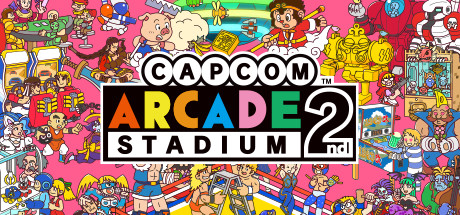


 Vampire Savior: The Lord of Vampire
Vampire Savior: The Lord of Vampire Darkstalkers: The Night Warriors
Darkstalkers: The Night Warriors Street Fighter Alpha: Warriors’ Dreams
Street Fighter Alpha: Warriors’ Dreams Capcom Sports Club
Capcom Sports Club


































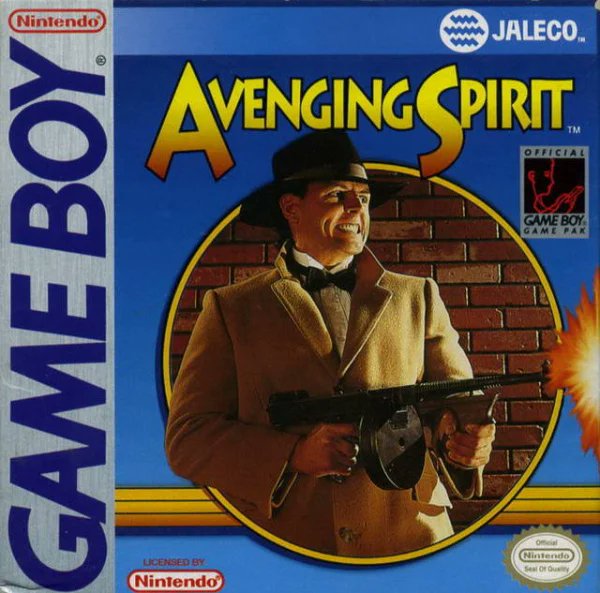

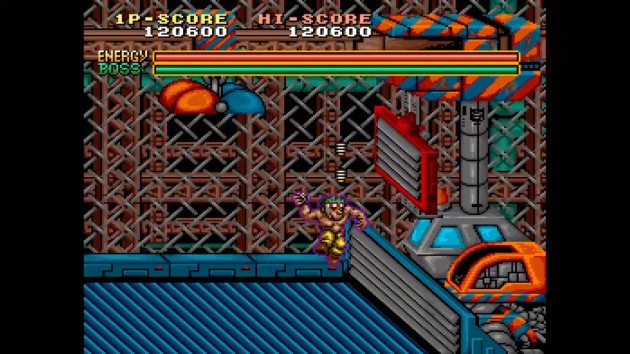
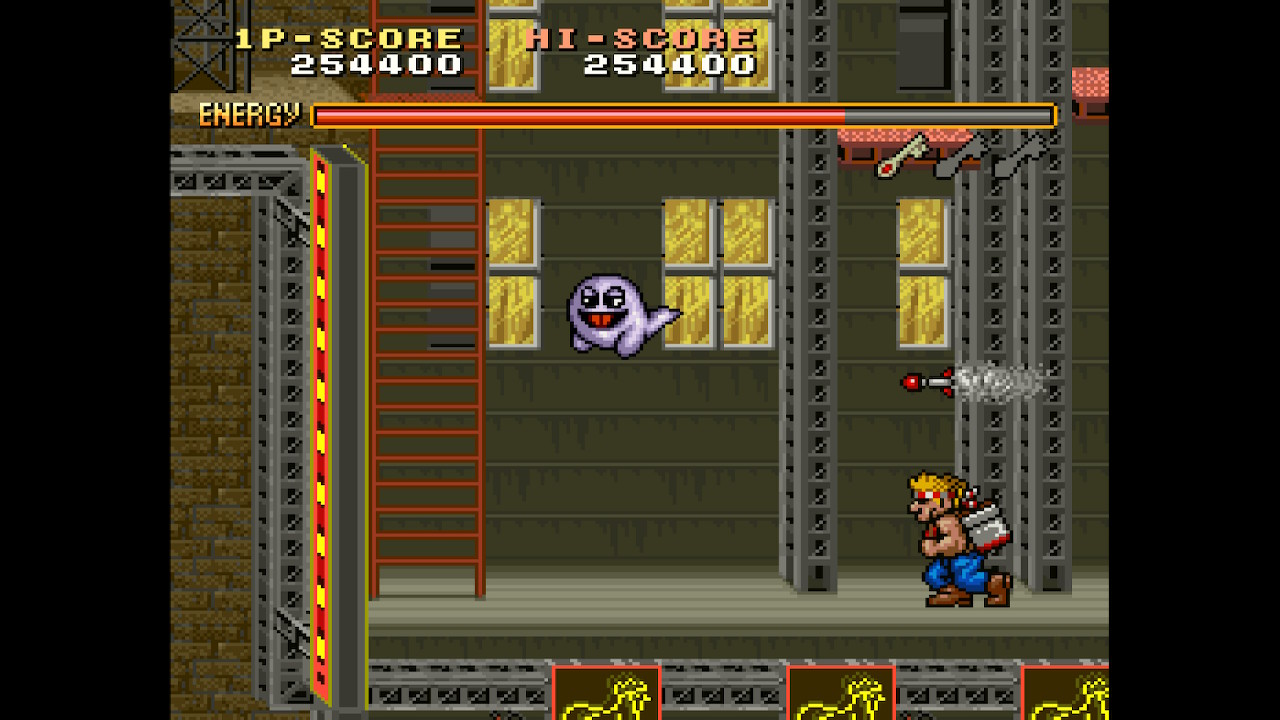
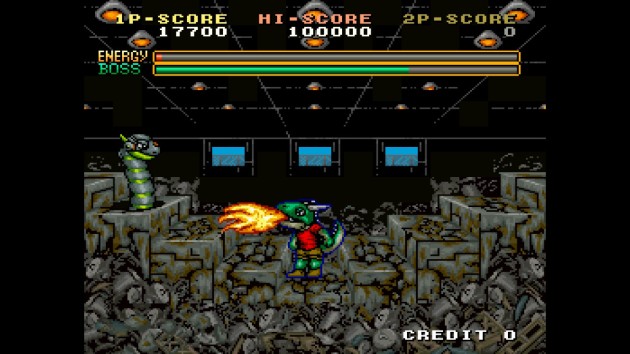

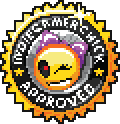 Plus, Ratalaika Games (yes, the company that was going to do the Indie Gamer Chick Collection of XBLIG classics, which fell through because it just wasn’t going to be economically possible to scrunch that many games from that many developers together) has done a pretty good job packaging it. It costs $2 less than Hamster’s Arcade Archives releases and features save states and rewind, plus the US and Japanese ROMs. They even created an easier-to-use “home experience” if that’s the route you want to take, or you can play the unmodified arcade ROM, with dip switches and everything. Yea, I wish the Game Boy ROM had been included, but I’m still stoked Avenging Spirit has a place in modern gaming. Hell, maybe this will be a best seller and it can finally become a franchise with new releases. Wouldn’t that be sweet? Maybe they’ll even get the box art right this time. Sorry, I’m not letting that go. Putting that cover on this game is so stupid that it’d be like putting Alfred Molina on the cover of Raiders of the Lost Ark.
Plus, Ratalaika Games (yes, the company that was going to do the Indie Gamer Chick Collection of XBLIG classics, which fell through because it just wasn’t going to be economically possible to scrunch that many games from that many developers together) has done a pretty good job packaging it. It costs $2 less than Hamster’s Arcade Archives releases and features save states and rewind, plus the US and Japanese ROMs. They even created an easier-to-use “home experience” if that’s the route you want to take, or you can play the unmodified arcade ROM, with dip switches and everything. Yea, I wish the Game Boy ROM had been included, but I’m still stoked Avenging Spirit has a place in modern gaming. Hell, maybe this will be a best seller and it can finally become a franchise with new releases. Wouldn’t that be sweet? Maybe they’ll even get the box art right this time. Sorry, I’m not letting that go. Putting that cover on this game is so stupid that it’d be like putting Alfred Molina on the cover of Raiders of the Lost Ark.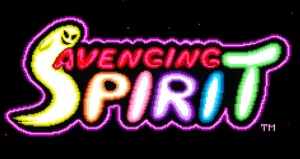
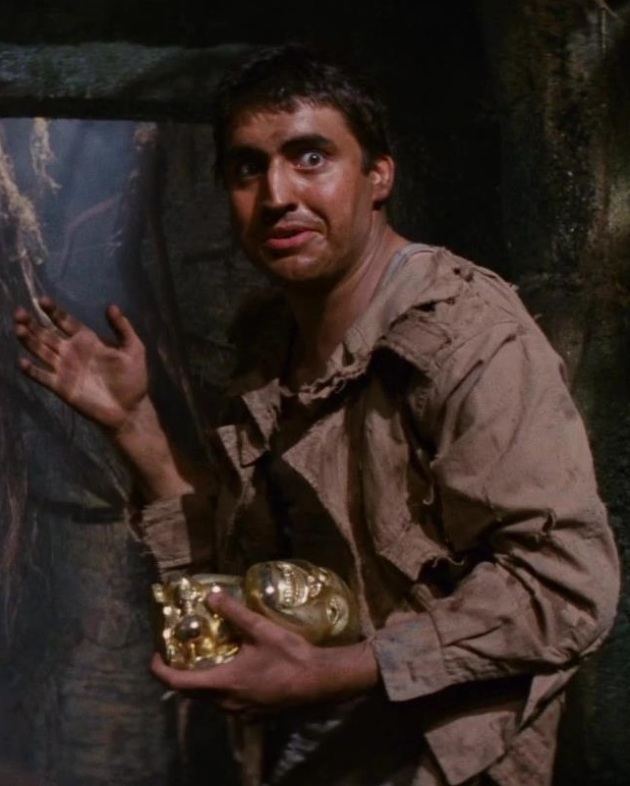
 This isn’t going to come as an incredible shock to you, but Cuphead: The Delicious Last Course is worth $7.99. For that money, you get six new bosses, a King Dice style single-phase mini-boss, and five single-phase mini-bosses where your guns don’t work at all and you can only win via parrying. You also get new guns that are the most powerful in the game, new charms that actually made me move off the smoke dash for the final boss, a new character that comes with totally different skills than Cuphead or Mugman, and a secret item that, once you finish messing around with it, basically activates God Mode. It’s a lot of content for eight bucks. As much fun as I had.. and I had blast.. I’m still somehow a bit disappointed. For DLC that took almost five years to make, I guess I was hoping more. Maybe a couple new Run ‘n Gun stages. At least one, right? Nope. No new Run ‘n Gun stages. Maybe more than one new shmup stage? Nope, just one. The best.. and worst.. thing I can say about The Last Delicious Course (doesn’t that sound better than Delicious Last Course?) is that I wish Studio MDHR had spent the last five years just making a sequel, because the content we actually got is spectacular.
This isn’t going to come as an incredible shock to you, but Cuphead: The Delicious Last Course is worth $7.99. For that money, you get six new bosses, a King Dice style single-phase mini-boss, and five single-phase mini-bosses where your guns don’t work at all and you can only win via parrying. You also get new guns that are the most powerful in the game, new charms that actually made me move off the smoke dash for the final boss, a new character that comes with totally different skills than Cuphead or Mugman, and a secret item that, once you finish messing around with it, basically activates God Mode. It’s a lot of content for eight bucks. As much fun as I had.. and I had blast.. I’m still somehow a bit disappointed. For DLC that took almost five years to make, I guess I was hoping more. Maybe a couple new Run ‘n Gun stages. At least one, right? Nope. No new Run ‘n Gun stages. Maybe more than one new shmup stage? Nope, just one. The best.. and worst.. thing I can say about The Last Delicious Course (doesn’t that sound better than Delicious Last Course?) is that I wish Studio MDHR had spent the last five years just making a sequel, because the content we actually got is spectacular.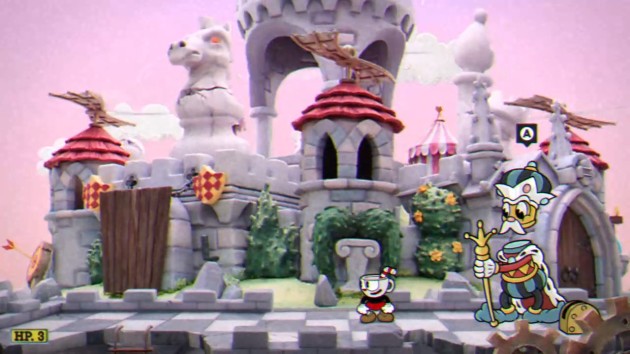
 I suspect they feel the same way and probably have buyer’s remorse that they announced DLC like four years ago. Maybe I’m wrong, but I get that vibe out of Cuphead D.L.C. All the heart from before is there. The bosses are creative (though the whole “you’ve never seen transformations like this” left me expecting much more grand set-pieces than what we got). Yet, after a certain point, I got the “we’re holding back a little” vibe out of it. But, at least you get a lot of value. Turning this $19.99 release into a $27.98 release basically gives you the easy mode-without-penalty everyone has wanted for five years now.
I suspect they feel the same way and probably have buyer’s remorse that they announced DLC like four years ago. Maybe I’m wrong, but I get that vibe out of Cuphead D.L.C. All the heart from before is there. The bosses are creative (though the whole “you’ve never seen transformations like this” left me expecting much more grand set-pieces than what we got). Yet, after a certain point, I got the “we’re holding back a little” vibe out of it. But, at least you get a lot of value. Turning this $19.99 release into a $27.98 release basically gives you the easy mode-without-penalty everyone has wanted for five years now. After beating the DLC, I started a new file where I used only Ms. Chalice for everything I was allowed to use her on (only Cuphead/Mugman can do the Mausoleums). I figured I’d need about 200 lives to beat the entire game with her. I actually did it with only 98 lives. Why’s that? Well, Ms. Chalice gets one extra hit point. That’s huge. It can be even more than that with her Super Art II, which is a shield that doesn’t go away until you take a hit (well, unless the game glitches out, and this DLC is glitchy as all hell). She has a shorter standard jump, BUT, she also has a double jump. The double jump by itself nerfs multiple levels and bosses. In fact, multiple coins and challenges in the Run ‘n Gun stages are completely annihilated by just that double jump.
After beating the DLC, I started a new file where I used only Ms. Chalice for everything I was allowed to use her on (only Cuphead/Mugman can do the Mausoleums). I figured I’d need about 200 lives to beat the entire game with her. I actually did it with only 98 lives. Why’s that? Well, Ms. Chalice gets one extra hit point. That’s huge. It can be even more than that with her Super Art II, which is a shield that doesn’t go away until you take a hit (well, unless the game glitches out, and this DLC is glitchy as all hell). She has a shorter standard jump, BUT, she also has a double jump. The double jump by itself nerfs multiple levels and bosses. In fact, multiple coins and challenges in the Run ‘n Gun stages are completely annihilated by just that double jump. The Delicious Last Course is glitchy as all hell. With the new charms and abilities that grant you extra life, I had planned on at long-last getting A+ scores on every boss. I worked hard to charge up the Cursed Relic into the Divine Relic and was all set to kick ass. Well, so much for that shit. My first match using the Divine Relic, the game said I scored a 0 in life, and like the careless manure farmer, I completely lost my shit. I replayed the level, did more or less as good, finished with three life again, and that time, it gave me credit for it. Huh? And that’s just one of many weird issues. During the very final boss of the DLC content, I used Ms. Chalice’s Super Art II for the extra shield. BUT, between phases, the shield stopped working. ONLY the animation for the shield was still there, as if it was working. But, it wasn’t. You can’t use Chalice’s Super Art II a second time until the first one breaks, yet, here it is.
The Delicious Last Course is glitchy as all hell. With the new charms and abilities that grant you extra life, I had planned on at long-last getting A+ scores on every boss. I worked hard to charge up the Cursed Relic into the Divine Relic and was all set to kick ass. Well, so much for that shit. My first match using the Divine Relic, the game said I scored a 0 in life, and like the careless manure farmer, I completely lost my shit. I replayed the level, did more or less as good, finished with three life again, and that time, it gave me credit for it. Huh? And that’s just one of many weird issues. During the very final boss of the DLC content, I used Ms. Chalice’s Super Art II for the extra shield. BUT, between phases, the shield stopped working. ONLY the animation for the shield was still there, as if it was working. But, it wasn’t. You can’t use Chalice’s Super Art II a second time until the first one breaks, yet, here it is.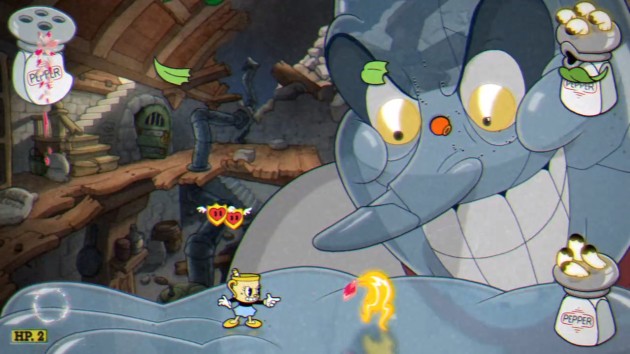
 The thing that royally frosts my ass about these glitches is Studio MDHR had five fucking years to get it right. FIVE! That’s over twice as long as the Dreamcast had in North America! That’s more than the entire lifespan of the Wii U. Think of all the games developed for those consoles, and remember this is just DLC.. a third of one game.. and yet I triggered these glitches on literally my very first attempt playing. So, these glitches, that myself and other players were constantly bumping into, somehow didn’t get noticed over a five year development cycle? Are you fucking shitting me? It’s so shameful. AND NO, I’m not advocating for crunch or angry that it took so long to come out. I’m angry that, even with all time, easy-to-trigger glitches were left in. Next time, Studio MDHR, hire people that suck and don’t tell them how to play the game. Just watch them play, and take notes.
The thing that royally frosts my ass about these glitches is Studio MDHR had five fucking years to get it right. FIVE! That’s over twice as long as the Dreamcast had in North America! That’s more than the entire lifespan of the Wii U. Think of all the games developed for those consoles, and remember this is just DLC.. a third of one game.. and yet I triggered these glitches on literally my very first attempt playing. So, these glitches, that myself and other players were constantly bumping into, somehow didn’t get noticed over a five year development cycle? Are you fucking shitting me? It’s so shameful. AND NO, I’m not advocating for crunch or angry that it took so long to come out. I’m angry that, even with all time, easy-to-trigger glitches were left in. Next time, Studio MDHR, hire people that suck and don’t tell them how to play the game. Just watch them play, and take notes.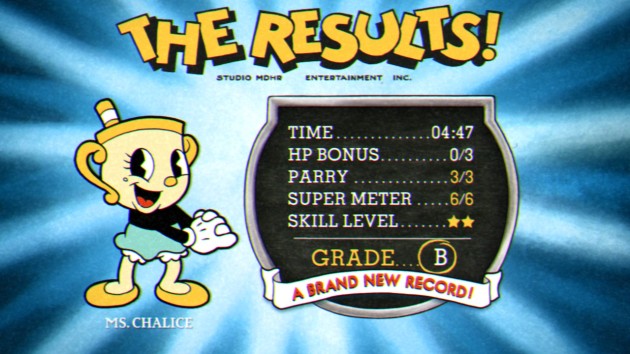
 What I figure must have happened was their play testers were just too good at Cuphead and didn’t take damage. The classic indie “I forgot that other people are going to play this and they will not have spent the last five years devoting their entire life to this and thus are likely to not play it as well” situation that I’ve seen over and over again for the last eleven years. Yea, games get glitchy, and yea, games get patches. But, these were not like some weird, obscure thing. They were right there, SO EASY to trigger, and yet in five years they never got found. It’s inexcusable.
What I figure must have happened was their play testers were just too good at Cuphead and didn’t take damage. The classic indie “I forgot that other people are going to play this and they will not have spent the last five years devoting their entire life to this and thus are likely to not play it as well” situation that I’ve seen over and over again for the last eleven years. Yea, games get glitchy, and yea, games get patches. But, these were not like some weird, obscure thing. They were right there, SO EASY to trigger, and yet in five years they never got found. It’s inexcusable. Assuming a Cuphead sequel ever hits, and they’ll probably need another decade at the rate they develop games, there’s a good chance I won’t be able to play it anymore. I have early onset Parkinson’s Disease, and on the table for me over the next decade, assuming I still have enough control over my fingers, is the loss of my reflexes. This could very well be my personal Cuphead finale. It’s been a long, strange, rambling journey. It was the announcement of this very DLC that made me realize that I never actually hated Cuphead. That I actually kind of loved it. Once I got over my anger at its snotty “git gud” attitude and the the fact that its studio is filled with douchebags who have no consideration for game accessibility, I realized that, when I beat Cuphead for the first time, it was one of the best times of my gaming life. And finally, the DLC is here.
Assuming a Cuphead sequel ever hits, and they’ll probably need another decade at the rate they develop games, there’s a good chance I won’t be able to play it anymore. I have early onset Parkinson’s Disease, and on the table for me over the next decade, assuming I still have enough control over my fingers, is the loss of my reflexes. This could very well be my personal Cuphead finale. It’s been a long, strange, rambling journey. It was the announcement of this very DLC that made me realize that I never actually hated Cuphead. That I actually kind of loved it. Once I got over my anger at its snotty “git gud” attitude and the the fact that its studio is filled with douchebags who have no consideration for game accessibility, I realized that, when I beat Cuphead for the first time, it was one of the best times of my gaming life. And finally, the DLC is here.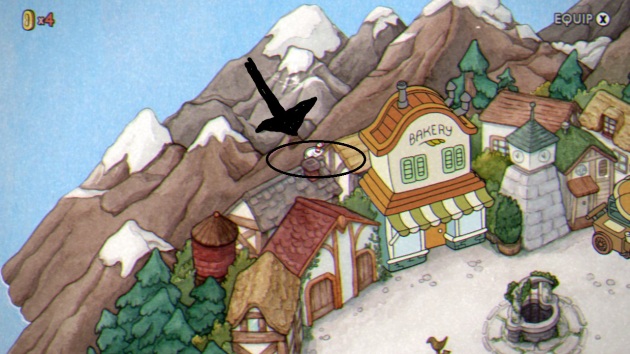
 The Delicious Last Course is fun. I don’t think the bosses are as mind-blowing or over-the-top as a lot of people were promising. Lots of reviewers talk about the six new bosses (eleven with the chess pieces) like they’re a cut above the previous bosses, but they’re not. They’re just new bosses. They’re on par with the previous ones, and the best thing I can say about them is none of them stand out as bad, though I found one to be underwhelming, and there was a phase or two here and there that was kind of boring. I didn’t love the shmup battle. I didn’t love the ice guy. But, I didn’t hate them, either. $8 for this set might be one of the best values any DLC set has ever had. I just wish the effort had gone to a full-blown sequel instead. Now, onto the definitive review..
The Delicious Last Course is fun. I don’t think the bosses are as mind-blowing or over-the-top as a lot of people were promising. Lots of reviewers talk about the six new bosses (eleven with the chess pieces) like they’re a cut above the previous bosses, but they’re not. They’re just new bosses. They’re on par with the previous ones, and the best thing I can say about them is none of them stand out as bad, though I found one to be underwhelming, and there was a phase or two here and there that was kind of boring. I didn’t love the shmup battle. I didn’t love the ice guy. But, I didn’t hate them, either. $8 for this set might be one of the best values any DLC set has ever had. I just wish the effort had gone to a full-blown sequel instead. Now, onto the definitive review..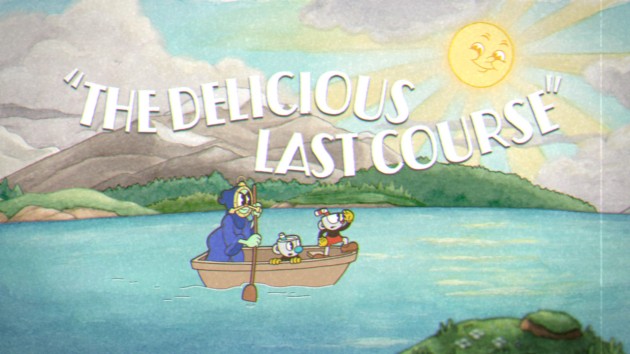
 The King of Games is what replaces the Run ‘n Gun Stages and especially the Mausoleums in Delicious Last Course. It’s a series of five boss battles where guns and charms don’t work (except Ms. Chalice’s charm) and you must parry to win. You can start the DLC here, if you wish (and you should since the coins are tied to these battles). The encounters happen between the full bosses.. maybe. Sometimes it lets you do more than one battle, or lets you even choose which battle you want to do, before kicking you off and disappearing for a while. This is also the only section of the DLC where content was cut from the game. There was to be a sixth battle featuring the King himself, and the code for this battle still exists within the game. While Studio MDHR annoys me with their shitty attitude towards accessibility and the fact that they released such a glitchy product even with five years to work on it, the one thing they have my full faith in is, if something gets cut, it got cut for a reason. I’m going to assume the King’s battle must have sucked, because the other five battles are pretty dang fun, even if some are super easy to beat.
The King of Games is what replaces the Run ‘n Gun Stages and especially the Mausoleums in Delicious Last Course. It’s a series of five boss battles where guns and charms don’t work (except Ms. Chalice’s charm) and you must parry to win. You can start the DLC here, if you wish (and you should since the coins are tied to these battles). The encounters happen between the full bosses.. maybe. Sometimes it lets you do more than one battle, or lets you even choose which battle you want to do, before kicking you off and disappearing for a while. This is also the only section of the DLC where content was cut from the game. There was to be a sixth battle featuring the King himself, and the code for this battle still exists within the game. While Studio MDHR annoys me with their shitty attitude towards accessibility and the fact that they released such a glitchy product even with five years to work on it, the one thing they have my full faith in is, if something gets cut, it got cut for a reason. I’m going to assume the King’s battle must have sucked, because the other five battles are pretty dang fun, even if some are super easy to beat.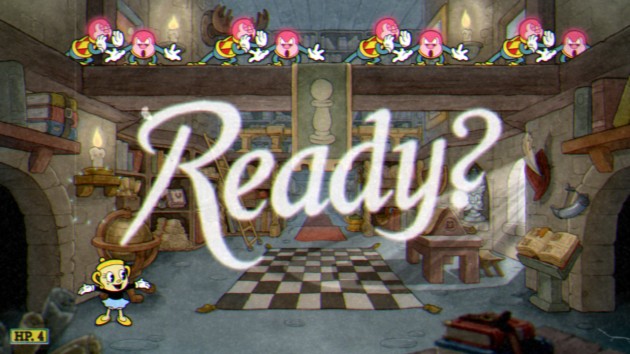
 The battle against the pawns is the only part of the chess fights that doesn’t feel like a boss, which is fitting, I guess. They leap down at you, and you have to avoid making contact while hitting a parry on their head. Even the pieces you defeat will return to the top to continue jumping down, and if you miss one, you have to wait for the other seven to cycle through their leaps before you get another crack at it. All of the chess battles feel like they were made with Ms. Chalice’s parry dash specifically in mind. In fact, this is the only one of those battles I actually beat using Cuphead, and that was only because I was bound and determined to ONLY use him at first with the DLC, but I gave that shit up. When you play as Cuphead/Mugman, hitting a parry also means throwing yourself into the sky and exposing yourself to the pawns, but Chalice can hit her parries low to the ground. Studio MDHR should have gone to Hasbro and offered to have them sponsor Ms. Chalice, because she absolutely Nerfs™ these battles.
The battle against the pawns is the only part of the chess fights that doesn’t feel like a boss, which is fitting, I guess. They leap down at you, and you have to avoid making contact while hitting a parry on their head. Even the pieces you defeat will return to the top to continue jumping down, and if you miss one, you have to wait for the other seven to cycle through their leaps before you get another crack at it. All of the chess battles feel like they were made with Ms. Chalice’s parry dash specifically in mind. In fact, this is the only one of those battles I actually beat using Cuphead, and that was only because I was bound and determined to ONLY use him at first with the DLC, but I gave that shit up. When you play as Cuphead/Mugman, hitting a parry also means throwing yourself into the sky and exposing yourself to the pawns, but Chalice can hit her parries low to the ground. Studio MDHR should have gone to Hasbro and offered to have them sponsor Ms. Chalice, because she absolutely Nerfs™ these battles. FOOD FOR THOUGHT: While I mourn the loss of the Run ‘n Gun stages, I’ll be damned if the chess stages aren’t a fun idea and keep what should be a stale formula fresh. It really helps that this opening battle is surprisingly intense. The rate and angles that the pawns jump down at you made me have a few close calls, and I even had a “died on the last one” a couple times. Granted, once I realized the chess battles were made for the chick, I’m like 6 for 0 with Ms. Chalice in this battle, but still, a nice opening sequence. This is probably the weakest of the chess battles in terms of play value and it’s still pretty dang good. A lot more fun than any of the Mausoleum stages. Like, it’s not even close. Great idea this was.
FOOD FOR THOUGHT: While I mourn the loss of the Run ‘n Gun stages, I’ll be damned if the chess stages aren’t a fun idea and keep what should be a stale formula fresh. It really helps that this opening battle is surprisingly intense. The rate and angles that the pawns jump down at you made me have a few close calls, and I even had a “died on the last one” a couple times. Granted, once I realized the chess battles were made for the chick, I’m like 6 for 0 with Ms. Chalice in this battle, but still, a nice opening sequence. This is probably the weakest of the chess battles in terms of play value and it’s still pretty dang good. A lot more fun than any of the Mausoleum stages. Like, it’s not even close. Great idea this was.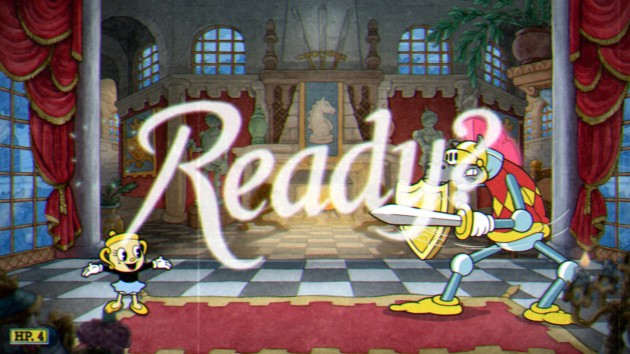
 By far.. BY FAR.. the chess piece that gave me the most trouble, the Knight is easily the deepest of the chess battles. First thing’s first: just use Chalice. The Knight battle feels like Nintendo’s Punch-Out!! franchise as a platformer, where counter-attacking is key, but most of those attacks are too high of a risk if you have to do the parry with an angled jump. The knight has three attacks that he telegraphs, and one that comes with no warning if you stand too far away for too long. Keep a medium distance. If he pokes his head out of his helmet, he’s going to do a big sweeping motion. If he kneels down low, he’s going to dart across the playfield. If he does an upper-cut, it’s a fake out. You can also score a hit when he taunts you, but it’s high risk. On the plus side, if you take damage, you have enough time to score two or three free hits before you stop blinking. You have to parry the pink plume to get him. Awesome battle!
By far.. BY FAR.. the chess piece that gave me the most trouble, the Knight is easily the deepest of the chess battles. First thing’s first: just use Chalice. The Knight battle feels like Nintendo’s Punch-Out!! franchise as a platformer, where counter-attacking is key, but most of those attacks are too high of a risk if you have to do the parry with an angled jump. The knight has three attacks that he telegraphs, and one that comes with no warning if you stand too far away for too long. Keep a medium distance. If he pokes his head out of his helmet, he’s going to do a big sweeping motion. If he kneels down low, he’s going to dart across the playfield. If he does an upper-cut, it’s a fake out. You can also score a hit when he taunts you, but it’s high risk. On the plus side, if you take damage, you have enough time to score two or three free hits before you stop blinking. You have to parry the pink plume to get him. Awesome battle!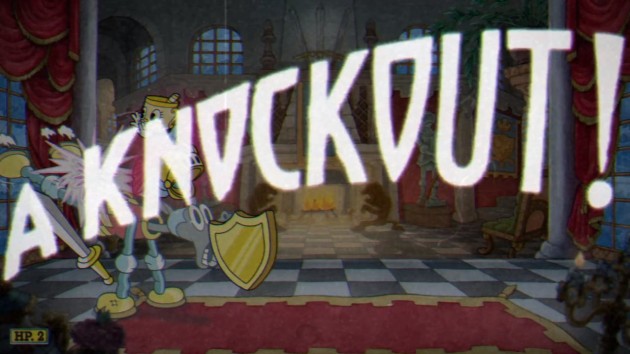
 Food For Thought: This is the last instance of “I wish this had been a full battle” I’ll have to deal with in a long time, but I’ll give credit to Studio MDHR: when they had a good single-phase concept, they ran with it. Most of the King Dice mini-bosses and all DLC the mini-bosses are really fun. Yea, I wish they’d been expanded into bigger rights (well, I could do without with the other Chess fights) but I’m happy we got what we got. Never pad anything out just because someone like me is going to bitch about it. Seriously. I know I’m sending mixed messages here, but excellent less is always better than uninspired more.
Food For Thought: This is the last instance of “I wish this had been a full battle” I’ll have to deal with in a long time, but I’ll give credit to Studio MDHR: when they had a good single-phase concept, they ran with it. Most of the King Dice mini-bosses and all DLC the mini-bosses are really fun. Yea, I wish they’d been expanded into bigger rights (well, I could do without with the other Chess fights) but I’m happy we got what we got. Never pad anything out just because someone like me is going to bitch about it. Seriously. I know I’m sending mixed messages here, but excellent less is always better than uninspired more.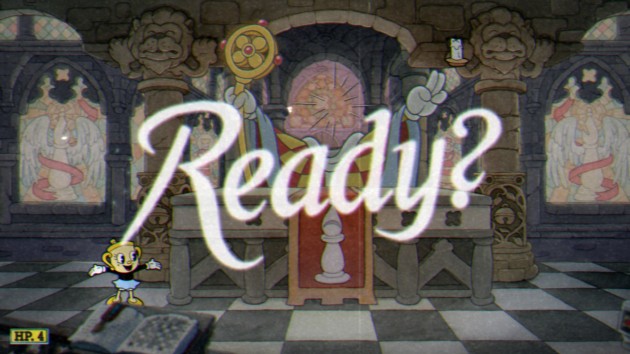
 The Bishop is a one-of-a-kind battle in Cuphead. While you do still have to directly attack him, the major mechanic of this fight is extinguishing the candles he lights. You just have to touch them instead of parrying them (surprised they didn’t work that out), and blowing them all out renders the Bishop vulnerable again. It’s a great idea, and it works. Maybe all this Cupheading has just made me awesome because I aced it on my first attempt. It wasn’t the only one I beat on my first attempt (I also totally lucked into beating the queen as well), but it’s not totally toothless as I died in my rematch with it the second time around. It’s a fight that’s tailor made for close encounters, and once I got over the shock of glorious victory, I have to admit, it’s quite fun.
The Bishop is a one-of-a-kind battle in Cuphead. While you do still have to directly attack him, the major mechanic of this fight is extinguishing the candles he lights. You just have to touch them instead of parrying them (surprised they didn’t work that out), and blowing them all out renders the Bishop vulnerable again. It’s a great idea, and it works. Maybe all this Cupheading has just made me awesome because I aced it on my first attempt. It wasn’t the only one I beat on my first attempt (I also totally lucked into beating the queen as well), but it’s not totally toothless as I died in my rematch with it the second time around. It’s a fight that’s tailor made for close encounters, and once I got over the shock of glorious victory, I have to admit, it’s quite fun.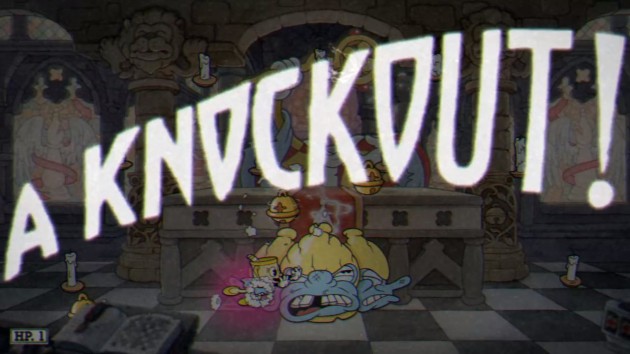
 FOOD FOR THOUGHT: I don’t think Studio MDHR is lacking for good ideas. Each of the chess matches is memorable, and the creepy-ass Bishop is particularly memorable. You don’t expect to see religious iconography in games like this, but you really don’t expect it to be a boss, in a church setting, with crosses and everything around. I admire the guts of it. Just think: Nintendo would have demanded this be altered not even ten years ago. We’ve come far.
FOOD FOR THOUGHT: I don’t think Studio MDHR is lacking for good ideas. Each of the chess matches is memorable, and the creepy-ass Bishop is particularly memorable. You don’t expect to see religious iconography in games like this, but you really don’t expect it to be a boss, in a church setting, with crosses and everything around. I admire the guts of it. Just think: Nintendo would have demanded this be altered not even ten years ago. We’ve come far.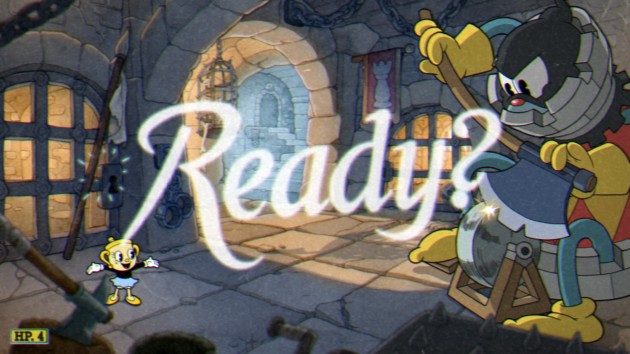
 While the Knight is probably the most well-rounded of all the chess matches, the Rook battle is my personal favorite. I love EVERYTHING about this fight. I love the character design. I love the heads. I love that he’s just ignoring you and sharpening his axe. I love the macabre vibe of it all. It’s also a satisfying battle. This is by far the most old school of all forty Cuphead bosses. Like someone took a spinning-plate/juggling-type LCD game (such as Nintendo’s Game & Watch Fire) and turned it into a boss fight. And it works wonderfully. This is as close to perfect as any mini-boss gets. Awesome death animation too.
While the Knight is probably the most well-rounded of all the chess matches, the Rook battle is my personal favorite. I love EVERYTHING about this fight. I love the character design. I love the heads. I love that he’s just ignoring you and sharpening his axe. I love the macabre vibe of it all. It’s also a satisfying battle. This is by far the most old school of all forty Cuphead bosses. Like someone took a spinning-plate/juggling-type LCD game (such as Nintendo’s Game & Watch Fire) and turned it into a boss fight. And it works wonderfully. This is as close to perfect as any mini-boss gets. Awesome death animation too.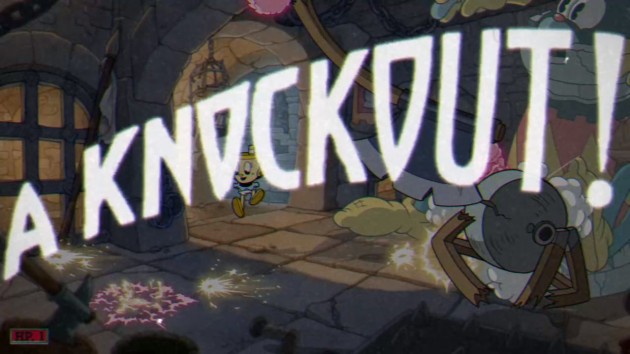
 FOOD FOR THOUGHT: I’m not a game developer, but I’d think that there’s a lot of inspiration to be had from the Rook. It takes very old-school gameplay and makes it fresh and exciting in 2022. What makes it feel so epic is the sheer scope of it. Of course, it’s a bit of smoke and mirrors and not really that different from how old 8 bit games used to dress up the bosses to make them look larger. Unlike a lot of the larger-than-life Cuphead bosses, you can see the seams here. What you’re really fighting is just a wall that launches projectiles, and if you bounce the projectiles back at the wall, it counts as a hit. The Rook is just an animation happening in the background. But, it all comes together to make a fight that feels so much larger than it really is.
FOOD FOR THOUGHT: I’m not a game developer, but I’d think that there’s a lot of inspiration to be had from the Rook. It takes very old-school gameplay and makes it fresh and exciting in 2022. What makes it feel so epic is the sheer scope of it. Of course, it’s a bit of smoke and mirrors and not really that different from how old 8 bit games used to dress up the bosses to make them look larger. Unlike a lot of the larger-than-life Cuphead bosses, you can see the seams here. What you’re really fighting is just a wall that launches projectiles, and if you bounce the projectiles back at the wall, it counts as a hit. The Rook is just an animation happening in the background. But, it all comes together to make a fight that feels so much larger than it really is.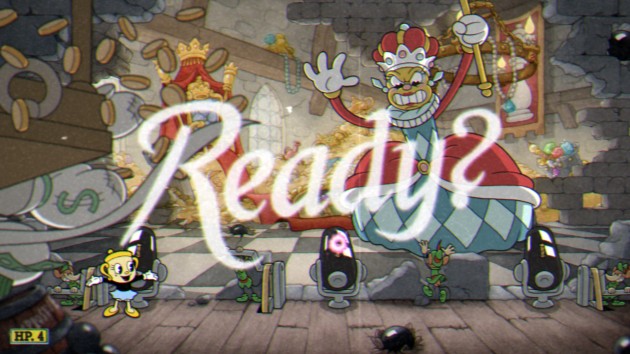
 Studio MDHR kind of sucks at mini-boss finales. Okay, that’s not totally fair. It’s not like the Queen here, or King Dice from the original build, are crappy to fight. They’re just underwhelming. Here, you have three cannons that sway back and forth, and you have to parry the fuses to shoot a cannon at the queen. She occasionally sends stacks of lions at you, but the real challenge is she has one of the hardest “make it rain” attack patterns in the game. Once you beat her, that’s it for the chess pieces. Beating the Bishop on my first try made me feel excellent. Here? I felt like I had lucked out. Like King Dice before her, I said “that’s it?” Well, there’s a boss rush for an achievement, but otherwise.. that’s it.
Studio MDHR kind of sucks at mini-boss finales. Okay, that’s not totally fair. It’s not like the Queen here, or King Dice from the original build, are crappy to fight. They’re just underwhelming. Here, you have three cannons that sway back and forth, and you have to parry the fuses to shoot a cannon at the queen. She occasionally sends stacks of lions at you, but the real challenge is she has one of the hardest “make it rain” attack patterns in the game. Once you beat her, that’s it for the chess pieces. Beating the Bishop on my first try made me feel excellent. Here? I felt like I had lucked out. Like King Dice before her, I said “that’s it?” Well, there’s a boss rush for an achievement, but otherwise.. that’s it.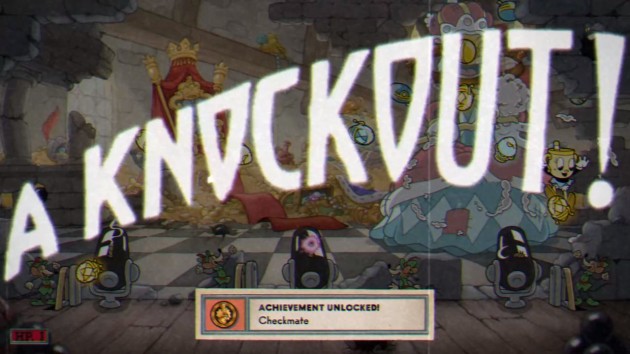
 FOOD FOR THOUGHT: Yea, they were out of ideas. Wait, wouldn’t it have made more sense for you to shoot cannonballs at the Rook, which is a castle? And wouldn’t it be more fitting as a tribute to the Queen of Hearts to have her send heads at you (“OFF WITH THEIR HEADS!”) that you have to bounce back at her? Now I’m wondering if I’m onto something. Granted, she wasn’t meant to be the final boss. You know, I pulled this out of my ass because these “Food for Thought” sections I pigeon-holed myself into doing can be tough to write after thirty-three bosses (and I’m writing this on my 33rd birthday. Meta!) but now I think I might be on to something. I’m pretty sure I’m not on something. Unless somebody put something in my water. Let’s not rule this out. Next!!
FOOD FOR THOUGHT: Yea, they were out of ideas. Wait, wouldn’t it have made more sense for you to shoot cannonballs at the Rook, which is a castle? And wouldn’t it be more fitting as a tribute to the Queen of Hearts to have her send heads at you (“OFF WITH THEIR HEADS!”) that you have to bounce back at her? Now I’m wondering if I’m onto something. Granted, she wasn’t meant to be the final boss. You know, I pulled this out of my ass because these “Food for Thought” sections I pigeon-holed myself into doing can be tough to write after thirty-three bosses (and I’m writing this on my 33rd birthday. Meta!) but now I think I might be on to something. I’m pretty sure I’m not on something. Unless somebody put something in my water. Let’s not rule this out. Next!!
 What does this do? Well, you can buy an item called the “Broken Relic” from the DLC shop for one coin. Winning this fight.. and it’s no slouch, even for a mini-boss.. changes the Broken Relic into the “Cursed Relic” which is going to be a pain in the ass for you if you want to use it. If you equip it, you only get one hit point to beat bosses with, and it randomizes your guns. Every time you let go of the fire button, use an EX shot, or dash, your gun changes. It’s crazy hard at first, but, it slowly gains more power as you beat more bosses.
What does this do? Well, you can buy an item called the “Broken Relic” from the DLC shop for one coin. Winning this fight.. and it’s no slouch, even for a mini-boss.. changes the Broken Relic into the “Cursed Relic” which is going to be a pain in the ass for you if you want to use it. If you equip it, you only get one hit point to beat bosses with, and it randomizes your guns. Every time you let go of the fire button, use an EX shot, or dash, your gun changes. It’s crazy hard at first, but, it slowly gains more power as you beat more bosses.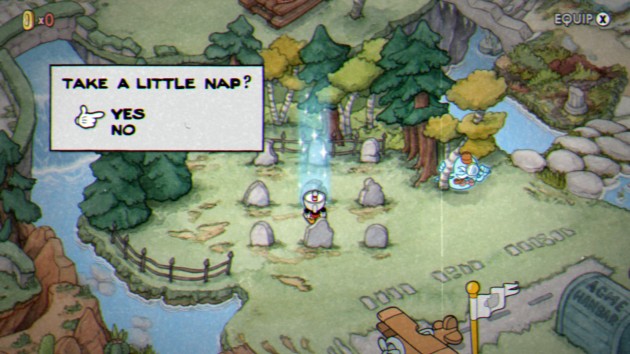
 Once you’ve beaten enough bosses (there’s a whole scoring system.
Once you’ve beaten enough bosses (there’s a whole scoring system. 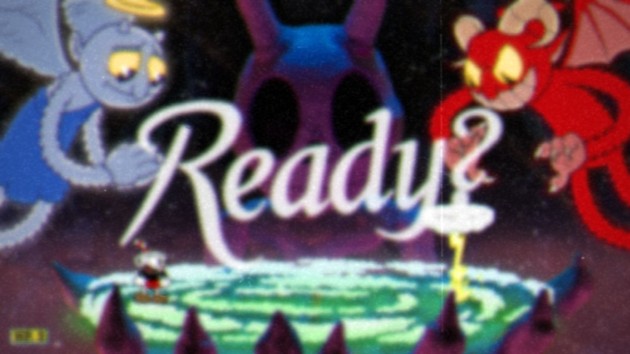
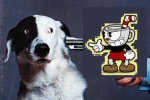 IGC Dislikes: That I actually did this boss last, and also the achievement is a reference to Castlevania II, which means
IGC Dislikes: That I actually did this boss last, and also the achievement is a reference to Castlevania II, which means  This is one of those “rub your belly and pat your head” bosses. I knew a guy who could do that while whistling, the freak. The idea here is, you will ALWAYS face the Demon, and if you turn around, the Demon and Angel will swap places. The Demon’s attacks will always hurt you. The Angel’s attacks will always pass harmlessly through you. It doesn’t sound very complicated, but holy crap, is this a balancing act. There’s also a platform that moves across the bottom that’s suspended by a lightning bolt that causes damage. Being an idiot, I didn’t notice the lightning bolt and thought the bottom caused damage depending on how you were facing. Once you get used to this, it’s fairly simple. I didn’t get used to it and only won by equipping the heart ring and parrying extra hearts and barely squeaking out wins. Awesome fight though. Fun fact: the Angel & Demon are, along with Goopy from Inkwell I, the only bosses that don’t attack you with minions.
This is one of those “rub your belly and pat your head” bosses. I knew a guy who could do that while whistling, the freak. The idea here is, you will ALWAYS face the Demon, and if you turn around, the Demon and Angel will swap places. The Demon’s attacks will always hurt you. The Angel’s attacks will always pass harmlessly through you. It doesn’t sound very complicated, but holy crap, is this a balancing act. There’s also a platform that moves across the bottom that’s suspended by a lightning bolt that causes damage. Being an idiot, I didn’t notice the lightning bolt and thought the bottom caused damage depending on how you were facing. Once you get used to this, it’s fairly simple. I didn’t get used to it and only won by equipping the heart ring and parrying extra hearts and barely squeaking out wins. Awesome fight though. Fun fact: the Angel & Demon are, along with Goopy from Inkwell I, the only bosses that don’t attack you with minions.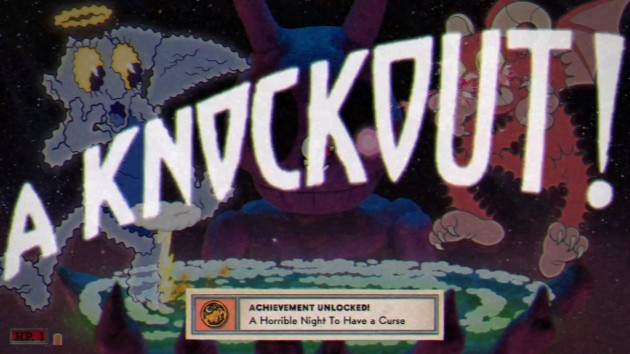

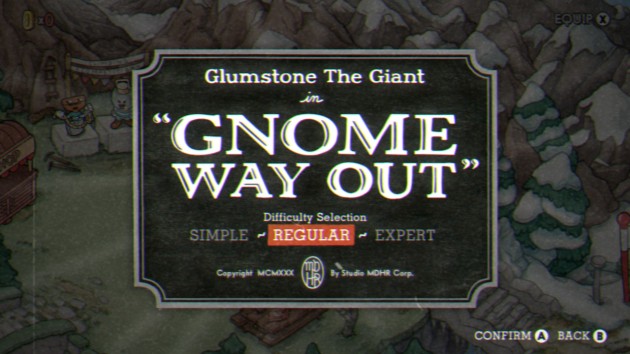
 Glumstone is basically the icon of Cuphead’s DLC. He was part of a graphic novel released in 2020, and is even featured in
Glumstone is basically the icon of Cuphead’s DLC. He was part of a graphic novel released in 2020, and is even featured in  PHASE ONE – VAPE MOUNTAINS (HEALTHIER ALTERNATIVE TO THE SMOKEY MOUNTAINS): Glumstone’s opening stage takes place on a series of platforms that move up and down, sometimes into the path of geese. You also have to watch out for gnomes that spit fireballs at you or climb up the platforms. The base is covered in spikes too, so stick to the platforms. Occasionally, he’ll also grab a bear and just bring it across the playfield, like the shark in Brineybeard’s fight, only it’s slower and a lot easier to dodge. Glumstone’s primary attack is opening his mouth and blowing clouds at you. If you’re not in close range, only Chalice will be able to reach all of them, as neither Cuphead nor Mugman can jump high enough to reach all of them. It’s a fun phase but easy compared to what’s coming next.
PHASE ONE – VAPE MOUNTAINS (HEALTHIER ALTERNATIVE TO THE SMOKEY MOUNTAINS): Glumstone’s opening stage takes place on a series of platforms that move up and down, sometimes into the path of geese. You also have to watch out for gnomes that spit fireballs at you or climb up the platforms. The base is covered in spikes too, so stick to the platforms. Occasionally, he’ll also grab a bear and just bring it across the playfield, like the shark in Brineybeard’s fight, only it’s slower and a lot easier to dodge. Glumstone’s primary attack is opening his mouth and blowing clouds at you. If you’re not in close range, only Chalice will be able to reach all of them, as neither Cuphead nor Mugman can jump high enough to reach all of them. It’s a fun phase but easy compared to what’s coming next. PHASE TWO – HANDBALL: See, even giants play with themselves using hand puppets. Wait, I didn’t mean it like that. I mean they play with their balls. NO, STOP! I mean they toss their balls back and forth. I mean with puppets. I mean, with their hands. Oh Christ, this is coming out all wrong. What I’m trying to say is the giant bats its ball back and forth while you watch for bulges underneath you. I mean little men coming at you while a bigger guy keeps tossing to himself. It’s a phase and it’s really hard. I mean to beat.
PHASE TWO – HANDBALL: See, even giants play with themselves using hand puppets. Wait, I didn’t mean it like that. I mean they play with their balls. NO, STOP! I mean they toss their balls back and forth. I mean with puppets. I mean, with their hands. Oh Christ, this is coming out all wrong. What I’m trying to say is the giant bats its ball back and forth while you watch for bulges underneath you. I mean little men coming at you while a bigger guy keeps tossing to himself. It’s a phase and it’s really hard. I mean to beat. PHASE THREE – IT’S NOT A TUMOR!!: I guess it’s supposed to be an ulcer but it looks more like cancer to me. Maybe if you just wait Glumstone out long enough he’ll die of natural causes. It’s a nice idea, since there’s like a million cartoons that do this gag, but it’s kind of underwhelming as a finale because it goes from feeling epic in scale to kind of small. But, the Pitfall! tribute is nice, and the difficulty balance is spot on. It’s clear why Glumstone got the lion’s share of pre-release hype. It’s the best of the bosses, besides Chef Saltbaker himself. In short: fun boss. Kind of a meh ending.
PHASE THREE – IT’S NOT A TUMOR!!: I guess it’s supposed to be an ulcer but it looks more like cancer to me. Maybe if you just wait Glumstone out long enough he’ll die of natural causes. It’s a nice idea, since there’s like a million cartoons that do this gag, but it’s kind of underwhelming as a finale because it goes from feeling epic in scale to kind of small. But, the Pitfall! tribute is nice, and the difficulty balance is spot on. It’s clear why Glumstone got the lion’s share of pre-release hype. It’s the best of the bosses, besides Chef Saltbaker himself. In short: fun boss. Kind of a meh ending.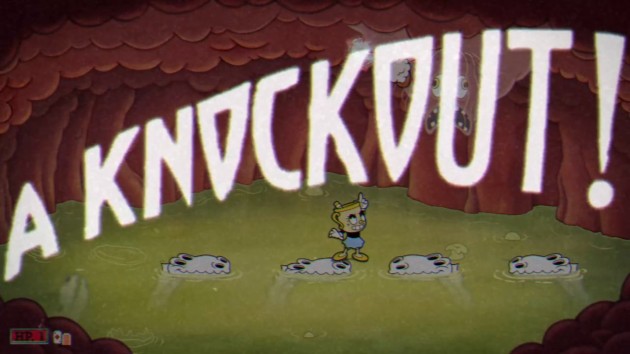
 FOOD FOR THOUGHT: Glumstone was one of those “on the drawing board a long time” bosses that makes Cuphead work so well. The magic of the art style is there’s dozens of cartoons that use a gigantic character, and Glumstone looks like all of them while somehow also looking like none of them. The ability to borrow liberally from this era and come very close without directly copying any character make for a wonderful resource and it’s awesome someone did such a good job of paying homage to it all.
FOOD FOR THOUGHT: Glumstone was one of those “on the drawing board a long time” bosses that makes Cuphead work so well. The magic of the art style is there’s dozens of cartoons that use a gigantic character, and Glumstone looks like all of them while somehow also looking like none of them. The ability to borrow liberally from this era and come very close without directly copying any character make for a wonderful resource and it’s awesome someone did such a good job of paying homage to it all.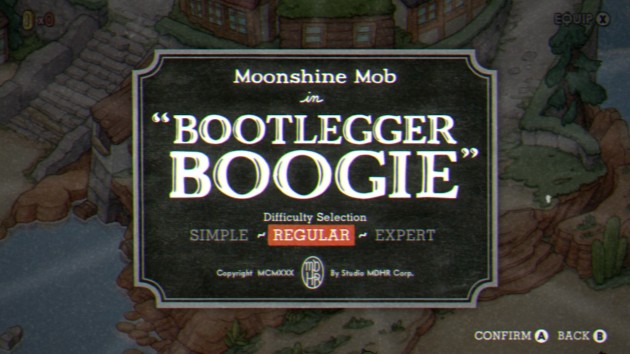
 Featuring not just one but two deleted concepts from the original build, the Moonshine Mob was the first boss I fought when I started up the DLC. Yet, it feels like a fight that could have been part of the base game, right up until a delightful (and for some, infuriating) twist at the end of the third phase. Bootlegger Boogie is the ideal DLC experience: it feels like it could have been there all along, yet it twists your expectations ever so slightly.
Featuring not just one but two deleted concepts from the original build, the Moonshine Mob was the first boss I fought when I started up the DLC. Yet, it feels like a fight that could have been part of the base game, right up until a delightful (and for some, infuriating) twist at the end of the third phase. Bootlegger Boogie is the ideal DLC experience: it feels like it could have been there all along, yet it twists your expectations ever so slightly. PHASE ONE – SPIDER MOBSTER: This is one of the deleted ideas.. kind of. Originally there was a shmup level where you fought the “
PHASE ONE – SPIDER MOBSTER: This is one of the deleted ideas.. kind of. Originally there was a shmup level where you fought the “ ♥Coppers using bug spray will occasionally walk out and shoot at you, some of which can be parried, though the angles to score one are quite tough.
♥Coppers using bug spray will occasionally walk out and shoot at you, some of which can be parried, though the angles to score one are quite tough. PHASE TWO – LIGHT BUG: The Light Bug is one of the earliest concepts for a stand-alone boss that didn’t happen. The attack pattern is, more or less, the same as it was as a prototype. The Light Bug dances back and forth on the second plane while six beams of “sound waves” circle around you. There’s a warning of when one set of three is going to change into an attack. Green is safe, yellow means “shit’s about to go down, yo” and red is dangerous. The attacks only happen briefly and once you get the hang of it, avoiding the attack is easy (and if you do it right, the Light Bug herself won’t be close to you when you switch between levels).
PHASE TWO – LIGHT BUG: The Light Bug is one of the earliest concepts for a stand-alone boss that didn’t happen. The attack pattern is, more or less, the same as it was as a prototype. The Light Bug dances back and forth on the second plane while six beams of “sound waves” circle around you. There’s a warning of when one set of three is going to change into an attack. Green is safe, yellow means “shit’s about to go down, yo” and red is dangerous. The attacks only happen briefly and once you get the hang of it, avoiding the attack is easy (and if you do it right, the Light Bug herself won’t be close to you when you switch between levels). This is where the crackshot becomes very valuable, as you don’t need to take aim and can focus on avoiding the beams. For the musically inclined, you can also use the music as a cue for when the attack will happen. There’s also cops and moonshine barrels running back and forth this whole time, and some of the barrels can be parried. I think I only scored one parry off a barrel the entire time. But, another fun phase!
This is where the crackshot becomes very valuable, as you don’t need to take aim and can focus on avoiding the beams. For the musically inclined, you can also use the music as a cue for when the attack will happen. There’s also cops and moonshine barrels running back and forth this whole time, and some of the barrels can be parried. I think I only scored one parry off a barrel the entire time. But, another fun phase! PHASE THREE – ANTEATER: Probably the most visually striking of all the DLC bosses, the Anteater’s arrival feels so damn epic. It’s a shame the actual battle becomes quite tedious. You get a chance to score some early damage on the real final boss at the start of the battle, but then the Anteater makes his move. He’s only vulnerable from his tongue. Ms. Chalice’s parry dash is almost worthless here, as the Anteater will take turns doing three to five trusts with his mouth on one side of the level, eventually sticking his tongue out across the screen. The tongue can be parried, and if you have the whetstone equipped, this battle goes a lot faster. In theory, you can time it with Ms. Chalice, but I never could.
PHASE THREE – ANTEATER: Probably the most visually striking of all the DLC bosses, the Anteater’s arrival feels so damn epic. It’s a shame the actual battle becomes quite tedious. You get a chance to score some early damage on the real final boss at the start of the battle, but then the Anteater makes his move. He’s only vulnerable from his tongue. Ms. Chalice’s parry dash is almost worthless here, as the Anteater will take turns doing three to five trusts with his mouth on one side of the level, eventually sticking his tongue out across the screen. The tongue can be parried, and if you have the whetstone equipped, this battle goes a lot faster. In theory, you can time it with Ms. Chalice, but I never could. Eventually, he’ll retract his tongue and unleash a brawl between a cop and a hoodlum that bounces around the screen like the caterpillar from earlier, only it takes A LOT more bullets to kill. He’ll then switch to the other side and repeat the same attack. After two hours, give or take, he’ll finally die. This would be a fun phase, only it takes FOREVER to finally score the knockout. Only, it’s NOT the knockout.
Eventually, he’ll retract his tongue and unleash a brawl between a cop and a hoodlum that bounces around the screen like the caterpillar from earlier, only it takes A LOT more bullets to kill. He’ll then switch to the other side and repeat the same attack. After two hours, give or take, he’ll finally die. This would be a fun phase, only it takes FOREVER to finally score the knockout. Only, it’s NOT the knockout. PHASE FOUR – SUDDENLY SNAIL: A banner drops down and the Snail declares KNOCKOUT sounding like Edward G. Robinson. The Anteater collapses and the final phase begins with the Snail shooting relatively quickly at you, though many of his shots can be parried. This is the fastest phase in all of Cuphead, and when the Snail dies after just a few shots, the real announcer clears his throat before declaring KNOCKOUT in a nice touch.
PHASE FOUR – SUDDENLY SNAIL: A banner drops down and the Snail declares KNOCKOUT sounding like Edward G. Robinson. The Anteater collapses and the final phase begins with the Snail shooting relatively quickly at you, though many of his shots can be parried. This is the fastest phase in all of Cuphead, and when the Snail dies after just a few shots, the real announcer clears his throat before declaring KNOCKOUT in a nice touch.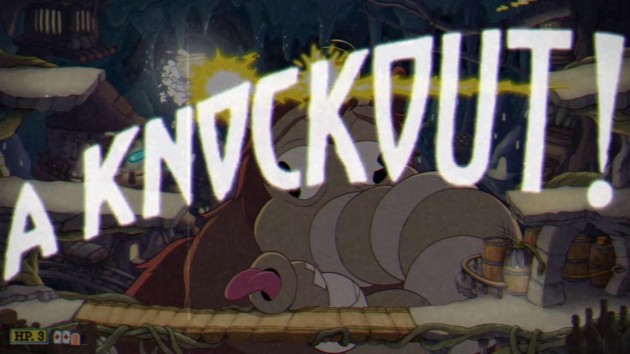
 FOOD FOR THOUGHT: I think this is pretty much it for the deleted content that got reworked into the game. It’s nice that they found a place for the “
FOOD FOR THOUGHT: I think this is pretty much it for the deleted content that got reworked into the game. It’s nice that they found a place for the “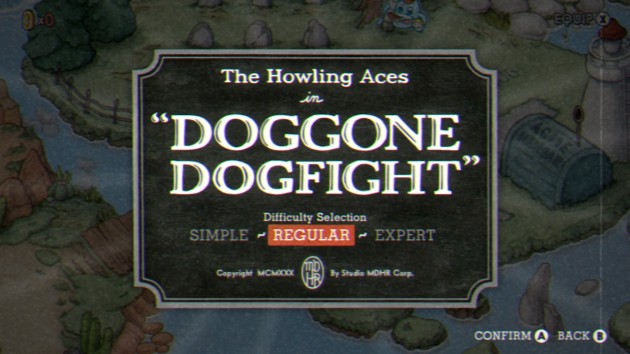
 Oh, I get it.. they’re dogs in a dog fight. As in airplanes. They’re not owned by Michael Vick. Right before I finally started to type this section of the review, I was informed there’s a secret phase. I spent the next four hours trying to get it, gave up, and had a tantrum. Then, a friend’s kid told me “use the Lobber” and I got it on my first try. Grumble. After all that effort, the DLC’s lone secret phase wasn’t remotely worth the effort. What a waste of time. Stick to the main path, where an otherwise generic theme becomes an unforgettable encounter.
Oh, I get it.. they’re dogs in a dog fight. As in airplanes. They’re not owned by Michael Vick. Right before I finally started to type this section of the review, I was informed there’s a secret phase. I spent the next four hours trying to get it, gave up, and had a tantrum. Then, a friend’s kid told me “use the Lobber” and I got it on my first try. Grumble. After all that effort, the DLC’s lone secret phase wasn’t remotely worth the effort. What a waste of time. Stick to the main path, where an otherwise generic theme becomes an unforgettable encounter. PHASE ONE – UNLEASH THE DOGS OF WAR: Hughes Canteen, the NPC that taught you about the airplane in Inkwell I, is your pilot. You stand on a plane that will go left and right depending on how close to each edge you stand. It’s actually very intuitive. There’s an alternate control scheme just for this level, but stick to the default because it works wonderfully. Using this setup, a bulldog pilot will fire slow-moving heat-seeking fire hydrants at you while other dogs rain tennis balls down on you. Occasionally, the bulldog will bail to either shoot you with giant yarn balls or throw boomerang bones at you, some of which can be parried. A nice little phase, though keeping up with the tennis balls is a pain in the butt, and sometimes the timing of them and the yarn attack conspire to screw you.
PHASE ONE – UNLEASH THE DOGS OF WAR: Hughes Canteen, the NPC that taught you about the airplane in Inkwell I, is your pilot. You stand on a plane that will go left and right depending on how close to each edge you stand. It’s actually very intuitive. There’s an alternate control scheme just for this level, but stick to the default because it works wonderfully. Using this setup, a bulldog pilot will fire slow-moving heat-seeking fire hydrants at you while other dogs rain tennis balls down on you. Occasionally, the bulldog will bail to either shoot you with giant yarn balls or throw boomerang bones at you, some of which can be parried. A nice little phase, though keeping up with the tennis balls is a pain in the butt, and sometimes the timing of them and the yarn attack conspire to screw you. PHASE TWO – YANKEE YIPPERS: Four dogs circle around you and throw letters at you, many of which can be parried. If you take your time before picking them off, you can easily charge your cards up during this phase. The dogs don’t take many hits at all, and the crackshot is especially useful here. This whole phase is over and done with in a matter of moments and you move on to the ultra-memorable finale. That is, unless you want to open the secret phase and ruin the best part of this entire boss.
PHASE TWO – YANKEE YIPPERS: Four dogs circle around you and throw letters at you, many of which can be parried. If you take your time before picking them off, you can easily charge your cards up during this phase. The dogs don’t take many hits at all, and the crackshot is especially useful here. This whole phase is over and done with in a matter of moments and you move on to the ultra-memorable finale. That is, unless you want to open the secret phase and ruin the best part of this entire boss.
 PHASE THREE – SHINOOK PILOT SALUKI: One of the best phases of Delicious Last Course, the battle against the Persian Greyhound (clearly the snootiest of all dogs) is truly a spectacle. It starts with mad scentists type of lasers that reminds me of something that would be used to fight Mighty Mouse. After a couple shots of that, the screen will rotate 90 degrees, and the controls along with it, and the Saluki will drop dog dishes on you that you have to jump over. The screen will go upside down after that. Once you get the hang of it, it’s actually a fairly simple battle, and it can even end by shooting the lasers and not the dog itself. It’s not much of a boss, but the gravity effects stand out and turn the mundane into something special. Of course, you can shirk all that and do the pathetic secret phase.
PHASE THREE – SHINOOK PILOT SALUKI: One of the best phases of Delicious Last Course, the battle against the Persian Greyhound (clearly the snootiest of all dogs) is truly a spectacle. It starts with mad scentists type of lasers that reminds me of something that would be used to fight Mighty Mouse. After a couple shots of that, the screen will rotate 90 degrees, and the controls along with it, and the Saluki will drop dog dishes on you that you have to jump over. The screen will go upside down after that. Once you get the hang of it, it’s actually a fairly simple battle, and it can even end by shooting the lasers and not the dog itself. It’s not much of a boss, but the gravity effects stand out and turn the mundane into something special. Of course, you can shirk all that and do the pathetic secret phase.
 DOG FOOD FOR THOUGHT: Like the Rook battle, The Howling Aces take bland, basic attacks and make them exciting by adding unique ways of tackling them. The airplane following your movement works, and I’m a sucker for gravity effects in games. If not for those things, this would be a very boring boss, as the secret phase proves. I’m not in love with the theme, and honestly, I kind of wish what they had done was merged the shump and platform sections. That’s the one thing Cuphead hasn’t done yet with its own formula. It’s probably impossible due to how it loads, but it’s all that’s left.
DOG FOOD FOR THOUGHT: Like the Rook battle, The Howling Aces take bland, basic attacks and make them exciting by adding unique ways of tackling them. The airplane following your movement works, and I’m a sucker for gravity effects in games. If not for those things, this would be a very boring boss, as the secret phase proves. I’m not in love with the theme, and honestly, I kind of wish what they had done was merged the shump and platform sections. That’s the one thing Cuphead hasn’t done yet with its own formula. It’s probably impossible due to how it loads, but it’s all that’s left.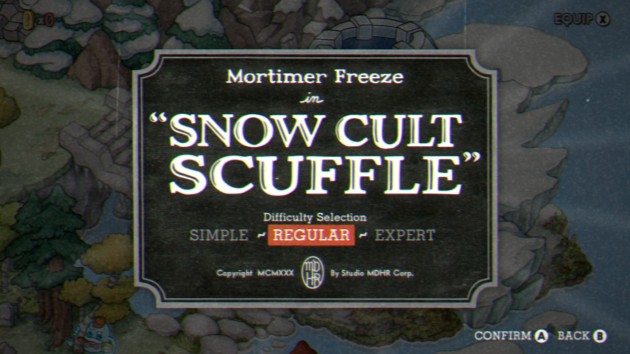
 Of the six DLC bosses, Mortimer feels the most like he belonged in the original game. He’s also probably the most middle-of-the-road of the five non-shmup bosses. It’s not a bad fight by any means, and it has some wonderful sight gags, but this is also the battle that I found to be the dullest. Get ready for some temperature based puns that would make the writers of Batman & Robin blush with shame.
Of the six DLC bosses, Mortimer feels the most like he belonged in the original game. He’s also probably the most middle-of-the-road of the five non-shmup bosses. It’s not a bad fight by any means, and it has some wonderful sight gags, but this is also the battle that I found to be the dullest. Get ready for some temperature based puns that would make the writers of Batman & Robin blush with shame. PHASE ONE – CHRIST, WHAT AN ICEHOLE: Mortimer has three ways of attacking. Apparently he’s a flasher, as his most common method of attack is opening his cloak to unleash tiny little ice monsters that spike themselves into the ground before coming to life and giving chase. It’s really tough to judge their trajectory while in flight, but once they land they’re easy enough to take out. He’ll usually then just slam a giant whale into the ground. If it hits the ice monsters, it’ll knock them out of the game in an adorably hilarious gag. Finally, he’ll shoot cards at you, which can sometimes be parried. Dull phase, really.
PHASE ONE – CHRIST, WHAT AN ICEHOLE: Mortimer has three ways of attacking. Apparently he’s a flasher, as his most common method of attack is opening his cloak to unleash tiny little ice monsters that spike themselves into the ground before coming to life and giving chase. It’s really tough to judge their trajectory while in flight, but once they land they’re easy enough to take out. He’ll usually then just slam a giant whale into the ground. If it hits the ice monsters, it’ll knock them out of the game in an adorably hilarious gag. Finally, he’ll shoot cards at you, which can sometimes be parried. Dull phase, really. PHASE TWO – SNOW MORE MR. ICE GUY: One of the hardest middle phases in the entire game, the Snow Monster is fast, aggressive, and specializes in crowding you in. He has a wide range of attacks, and between those he might turn into a snowball and roll or leap back and forth across the screen. If the obstacles from his previous attack are still active, it’ll be difficult to dodge. He’ll also slam the ground and cause ice blades to poke up from the ground.
PHASE TWO – SNOW MORE MR. ICE GUY: One of the hardest middle phases in the entire game, the Snow Monster is fast, aggressive, and specializes in crowding you in. He has a wide range of attacks, and between those he might turn into a snowball and roll or leap back and forth across the screen. If the obstacles from his previous attack are still active, it’ll be difficult to dodge. He’ll also slam the ground and cause ice blades to poke up from the ground. By far his most common attack is turning into a fridge and shooting ice cubes at you. When the cubes land, they break into smaller cubes. If the starting cube is large, it’ll have two break sequences. They’re easy enough dodge, but it’s when he quickly transitions to the rolling attack that this phase becomes a pain in the butt. He’ll also close the fridge attack by launching evil popcicles at you, some of which can be parried. When you do enough damage, a series of platforms appears that takes you to the finale. The Snow Monster took me longer to complete than almost any second phase and probably should have been the last phase.
By far his most common attack is turning into a fridge and shooting ice cubes at you. When the cubes land, they break into smaller cubes. If the starting cube is large, it’ll have two break sequences. They’re easy enough dodge, but it’s when he quickly transitions to the rolling attack that this phase becomes a pain in the butt. He’ll also close the fridge attack by launching evil popcicles at you, some of which can be parried. When you do enough damage, a series of platforms appears that takes you to the finale. The Snow Monster took me longer to complete than almost any second phase and probably should have been the last phase. PHASE THREE – OKAY, SNOWFLAKE: After climbing up the platforms, you reach a rotating set of five platforms for the final form of Mortimer. The giant snowflake finale has an attack that never once hit me. He shoots out.. like.. a ghost that circles around the outside. I don’t even know if it can damage you or if it’s just a few seconds of getting free attacks. His other attacks are more dangerous. He’ll launch buckets at you, some of which can be parried. After they hit the wall, the buckets turn into three moons that you have to dodge. He’ll also shoot ice cream cones from four directions at once, or launch his eyeball at you. The eyeball has beams that you must also avoid. A decent finale to an otherwise ho-hum battle.
PHASE THREE – OKAY, SNOWFLAKE: After climbing up the platforms, you reach a rotating set of five platforms for the final form of Mortimer. The giant snowflake finale has an attack that never once hit me. He shoots out.. like.. a ghost that circles around the outside. I don’t even know if it can damage you or if it’s just a few seconds of getting free attacks. His other attacks are more dangerous. He’ll launch buckets at you, some of which can be parried. After they hit the wall, the buckets turn into three moons that you have to dodge. He’ll also shoot ice cream cones from four directions at once, or launch his eyeball at you. The eyeball has beams that you must also avoid. A decent finale to an otherwise ho-hum battle.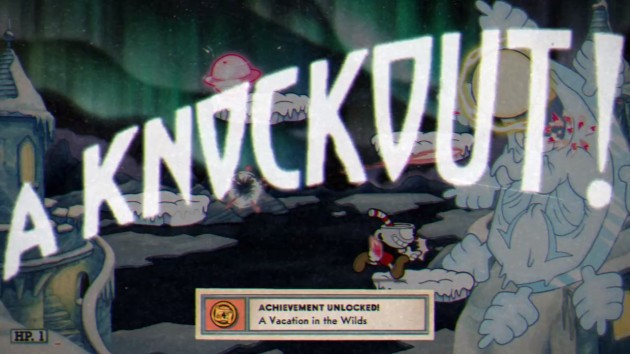
 FOOD FOR THOUGHT: Mortimer is the only of the four traditional bosses that feels like he could only belong in Inkwell III. The other three would fit in more as Inkwell II battles, with Moonshine Mob being on the fringe only because of the Anteater section’s sponge. There’s something about this particular fight that feels climatic or end gamish. Then again, a lot of people insist to me that I’m crazy for thinking Brineybeard belongs in Inkwell I so take that with a grain of salt.
FOOD FOR THOUGHT: Mortimer is the only of the four traditional bosses that feels like he could only belong in Inkwell III. The other three would fit in more as Inkwell II battles, with Moonshine Mob being on the fringe only because of the Anteater section’s sponge. There’s something about this particular fight that feels climatic or end gamish. Then again, a lot of people insist to me that I’m crazy for thinking Brineybeard belongs in Inkwell I so take that with a grain of salt.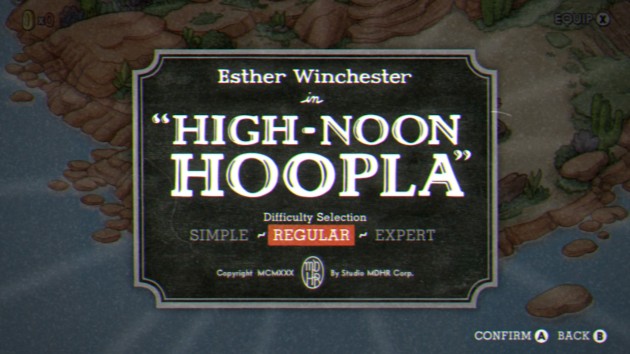
 I’m so disappointed that there’s only one shmup section in the DLC. I want an all-shmup Cuphead sequel more than I want to live into my 80s. While Esther isn’t among the best of the shmup encounters in the game, she’s still a ton of fun to do battle with. Fun fact: this was the boss that I needed the most lives and time to defeat in the DLC, and by a wide margin.
I’m so disappointed that there’s only one shmup section in the DLC. I want an all-shmup Cuphead sequel more than I want to live into my 80s. While Esther isn’t among the best of the shmup encounters in the game, she’s still a ton of fun to do battle with. Fun fact: this was the boss that I needed the most lives and time to defeat in the DLC, and by a wide margin. PHASE ONE – REAL C.O.W. GIRL OF SHMUP MESA: In the first phase, you have to switch between and upper and lower area. Esther’s primary method of defeating you is by having one of the most visually busy sections of the game. She fires oil out of guns that crosses halfway across the screen before doubling back and coming back at you as snakes (wait, I get it.. snake oil! See, I thought it was ink). Her only other direct attack is to lasso a cactus that will block the entire channel she’s on.
PHASE ONE – REAL C.O.W. GIRL OF SHMUP MESA: In the first phase, you have to switch between and upper and lower area. Esther’s primary method of defeating you is by having one of the most visually busy sections of the game. She fires oil out of guns that crosses halfway across the screen before doubling back and coming back at you as snakes (wait, I get it.. snake oil! See, I thought it was ink). Her only other direct attack is to lasso a cactus that will block the entire channel she’s on. The real challenge comes from vultures that drop dynamite into the playfield. The dynamite explodes into five separate explosions of three, then two (four and then three on Expert). AND while all that’s happening, a horse will fly across the screen and spit cactus balls at you, some of which can be parried. You can shoot the horses down, but you give up parry chances. There’s just a ton of stuff to keep track of here and it becomes overwhelming.
The real challenge comes from vultures that drop dynamite into the playfield. The dynamite explodes into five separate explosions of three, then two (four and then three on Expert). AND while all that’s happening, a horse will fly across the screen and spit cactus balls at you, some of which can be parried. You can shoot the horses down, but you give up parry chances. There’s just a ton of stuff to keep track of here and it becomes overwhelming. PHASE TWO – HEY NOW, THAT’S NOT THE CODE OF THE WEST: In a sort of opposite of one of Djimmi’s attacks, Esther pulls out a vacuum and beings sucking loot up, and you along with it. After dodging all the debris, she’ll then bend over and launch safes onto the playfield. When the safes hit the ground, they explode into the loot she previously collected, some of which can now be parried. It’s a basic dodging type of stage that goes quickly, and once you defeat it, this wholesome boss suddenly takes a turn at the corner of Dark and Macabre.
PHASE TWO – HEY NOW, THAT’S NOT THE CODE OF THE WEST: In a sort of opposite of one of Djimmi’s attacks, Esther pulls out a vacuum and beings sucking loot up, and you along with it. After dodging all the debris, she’ll then bend over and launch safes onto the playfield. When the safes hit the ground, they explode into the loot she previously collected, some of which can now be parried. It’s a basic dodging type of stage that goes quickly, and once you defeat it, this wholesome boss suddenly takes a turn at the corner of Dark and Macabre. PHASE THREE – 😶 : The cow gets sucked into the pressure cooker and turned into hot dogs.
PHASE THREE – 😶 : The cow gets sucked into the pressure cooker and turned into hot dogs. PHASE FOUR – A REAL SAUSAGE FEST: The final shmup phase of Cuphead has you now fighting an entire can of hot dogs (do hotdogs come in tins like that?) with two giant arms extending from it. The arms scissor back and forth, but there’s safe spots where no dog is that you can pass safely through. While this is going on, the can shoots waves of chili peppers at you, one of which can always be parried. Resist the temptation to chase one down if it’s not in front of you and focus on dodging the arms. It’s pretty spongy but a wonderful ending to my surprise favorite type of Cuphead levels.
PHASE FOUR – A REAL SAUSAGE FEST: The final shmup phase of Cuphead has you now fighting an entire can of hot dogs (do hotdogs come in tins like that?) with two giant arms extending from it. The arms scissor back and forth, but there’s safe spots where no dog is that you can pass safely through. While this is going on, the can shoots waves of chili peppers at you, one of which can always be parried. Resist the temptation to chase one down if it’s not in front of you and focus on dodging the arms. It’s pretty spongy but a wonderful ending to my surprise favorite type of Cuphead levels.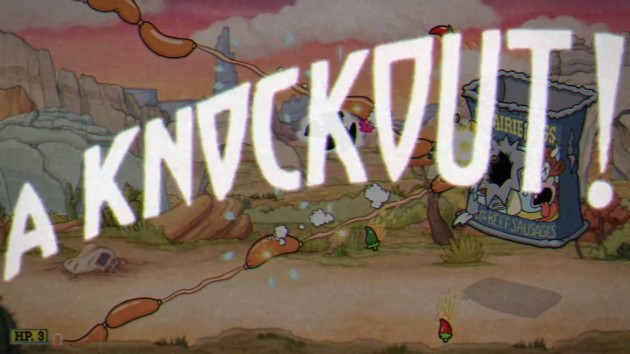
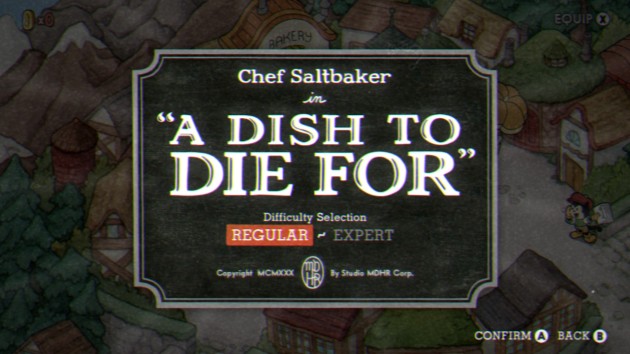
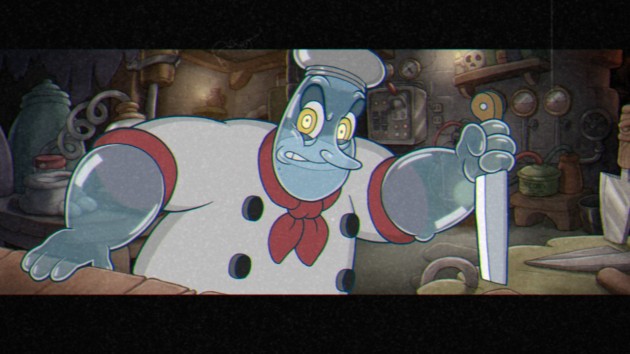
 In what is the least shocking twist ever, Chef Saltbaker was a bad guy all along, and the battle against him is so mean spirited and evil that the smile never left my face. This, ladies and gentlemen, is one of the most memorable last bosses in gaming history. Well, except that it gets easier as it goes along. Seriously, the first phase is a frantic dodge-a-thon, but while the visuals remain striking throughout, the actual battle gets kind cinchy.
In what is the least shocking twist ever, Chef Saltbaker was a bad guy all along, and the battle against him is so mean spirited and evil that the smile never left my face. This, ladies and gentlemen, is one of the most memorable last bosses in gaming history. Well, except that it gets easier as it goes along. Seriously, the first phase is a frantic dodge-a-thon, but while the visuals remain striking throughout, the actual battle gets kind cinchy. PHASE ONE – CASUAL CRUELTY: All the items are you’ve gathered from defeating the five primary DLC bosses? Yea, the Chef murders them in cold blood with a smile on his face. It’s violent and gruesome and FUCKING AWESOME! Like all professional chefs, this guy is just 100% pure evil. He has four attacks: shooting limes that hover over you, sugar cubes that bounce at you (some of which can be parried), cookies that bounce at you, and strawberries that rain down upon you. None of them are hard to dodge on their own, but the attacks can and do stack. And, while this happens, there’s a fire that jumps from the floor to the ceiling and is super easy to lose track of. One of the most intense and brutal phases in the game.
PHASE ONE – CASUAL CRUELTY: All the items are you’ve gathered from defeating the five primary DLC bosses? Yea, the Chef murders them in cold blood with a smile on his face. It’s violent and gruesome and FUCKING AWESOME! Like all professional chefs, this guy is just 100% pure evil. He has four attacks: shooting limes that hover over you, sugar cubes that bounce at you (some of which can be parried), cookies that bounce at you, and strawberries that rain down upon you. None of them are hard to dodge on their own, but the attacks can and do stack. And, while this happens, there’s a fire that jumps from the floor to the ceiling and is super easy to lose track of. One of the most intense and brutal phases in the game. PHASE TWO – SALTED NUKES: Yea, this is the most visually awesome sequence in the entire game. It’s so awesome. Here, you shoot four pepper shakers that crash into Chef Saltbaker and progressively crack him. The pepper shakers shoot projectiles, some of which can be parried, and leafs rain down from the ceiling from time to time. The fire from the previous stage is back as well. I highly recommend the crackshot for this battle. When you’ve done enough damage, you’ve earned a break with one of the easiest and quickest phases in any boss fight.
PHASE TWO – SALTED NUKES: Yea, this is the most visually awesome sequence in the entire game. It’s so awesome. Here, you shoot four pepper shakers that crash into Chef Saltbaker and progressively crack him. The pepper shakers shoot projectiles, some of which can be parried, and leafs rain down from the ceiling from time to time. The fire from the previous stage is back as well. I highly recommend the crackshot for this battle. When you’ve done enough damage, you’ve earned a break with one of the easiest and quickest phases in any boss fight. PHASE THREE – WHAT SLUGS HAVE NIGHTMARES OF: This phase seriously lasts like ten seconds, if that. Two salt things that look kind of like the Stay Puff Marshmallow Man dance up and down. It’s an easy pattern that you can dash under. There’s a saw blade on the ground too but, yea, this is a layup and a break between the real finale of Cuphead. Take a breather, plug these guys with a couple shots, and move on.
PHASE THREE – WHAT SLUGS HAVE NIGHTMARES OF: This phase seriously lasts like ten seconds, if that. Two salt things that look kind of like the Stay Puff Marshmallow Man dance up and down. It’s an easy pattern that you can dash under. There’s a saw blade on the ground too but, yea, this is a layup and a break between the real finale of Cuphead. Take a breather, plug these guys with a couple shots, and move on. PHASE FOUR – TOO MUCH SALT IS KNOWN TO CAUSE HEART ATTACKS: This is it! After beating the salt dancers, the floor starts to break apart and two lethal-to-the-touch columns of salt spring up. Most importantly, a series of platforms start to appear. If you don’t have Ms. Chalice’s double jump, this section is so much harder. After a few seconds of jumping from platform to platform, the Chef’s heart will appear. You have to shoot it, and apparently it can be parried too though it doesn’t seem necessary to killing it. It’s a bit of a letdown for a finale, especially with how epic those first two phases were. But, that’s it. Unless there’s even more surprise DLC or a sequel coming, this was the final phase of Cuphead.
PHASE FOUR – TOO MUCH SALT IS KNOWN TO CAUSE HEART ATTACKS: This is it! After beating the salt dancers, the floor starts to break apart and two lethal-to-the-touch columns of salt spring up. Most importantly, a series of platforms start to appear. If you don’t have Ms. Chalice’s double jump, this section is so much harder. After a few seconds of jumping from platform to platform, the Chef’s heart will appear. You have to shoot it, and apparently it can be parried too though it doesn’t seem necessary to killing it. It’s a bit of a letdown for a finale, especially with how epic those first two phases were. But, that’s it. Unless there’s even more surprise DLC or a sequel coming, this was the final phase of Cuphead.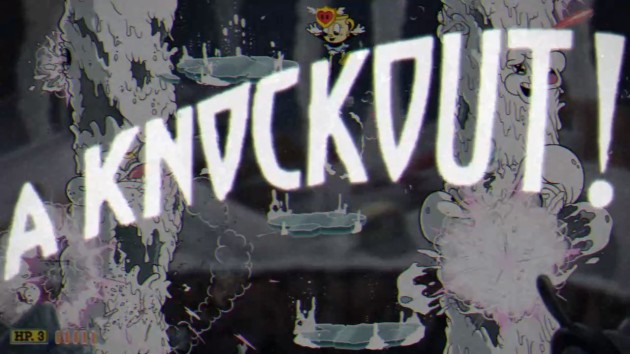
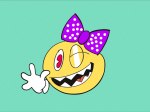
 To all my readers, thanks for the support over the last eleven years.
To all my readers, thanks for the support over the last eleven years. Everyone at Indie Gamer Team, you’re all my friends and I love you so much.
Everyone at Indie Gamer Team, you’re all my friends and I love you so much.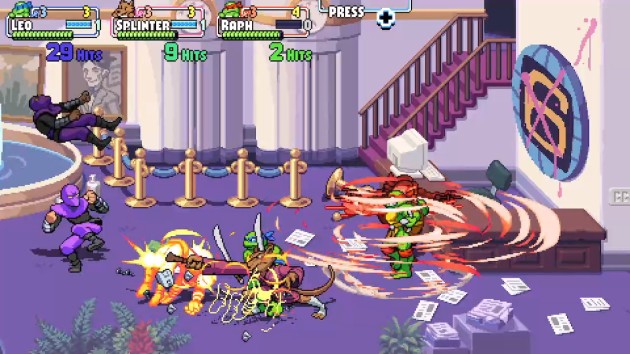

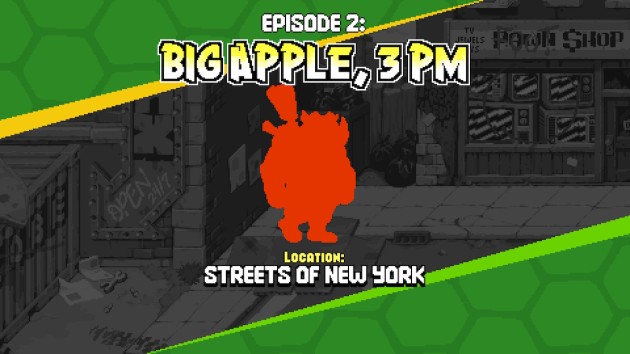
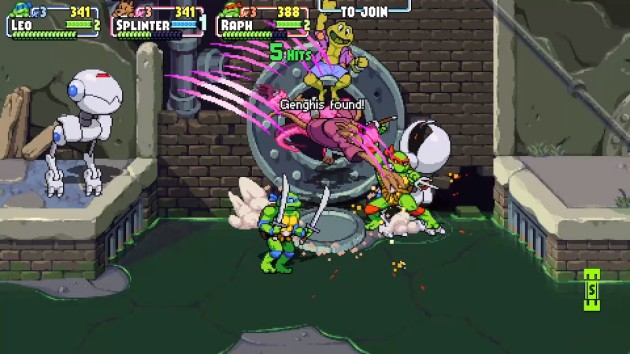
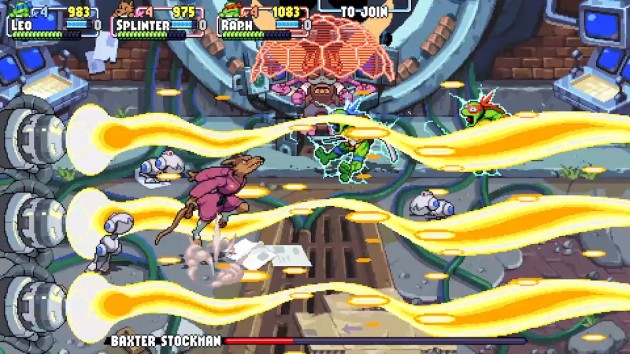
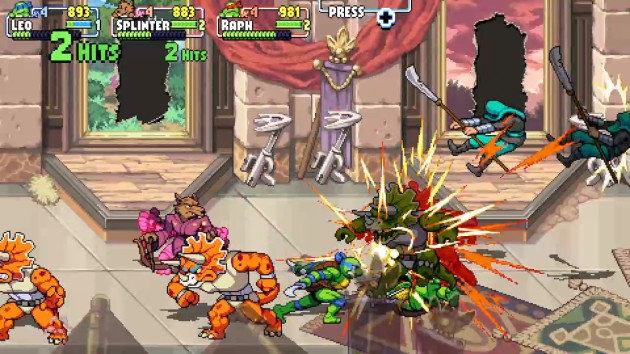
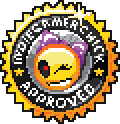 Teenage Mutant Ninja Turtles: Shredder’s Revenge is Chick-Approved
Teenage Mutant Ninja Turtles: Shredder’s Revenge is Chick-Approved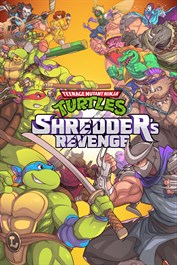 Teenage Mutant Ninja Turtles: Shredder’s Revenge was developed by Tribute Games
Teenage Mutant Ninja Turtles: Shredder’s Revenge was developed by Tribute Games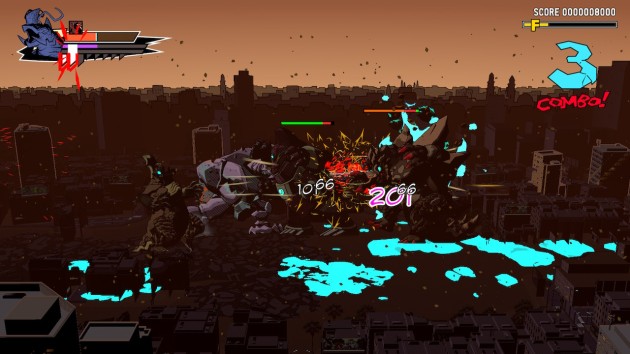
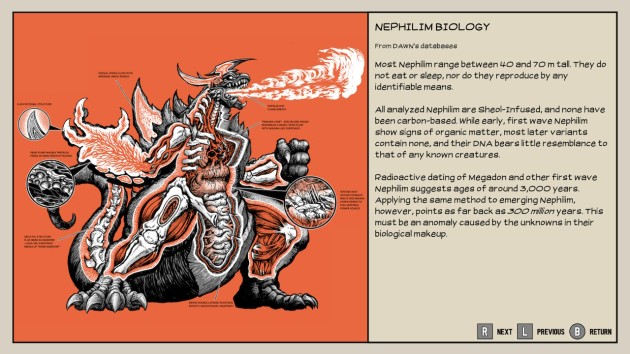
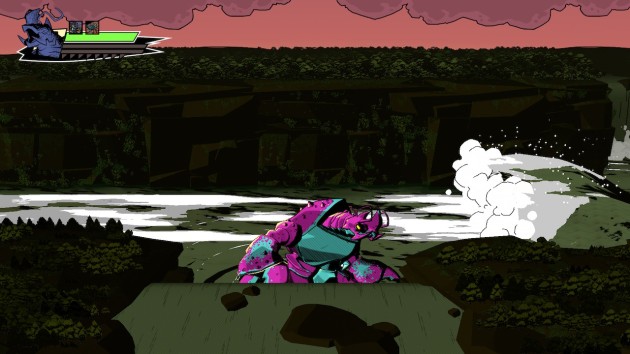
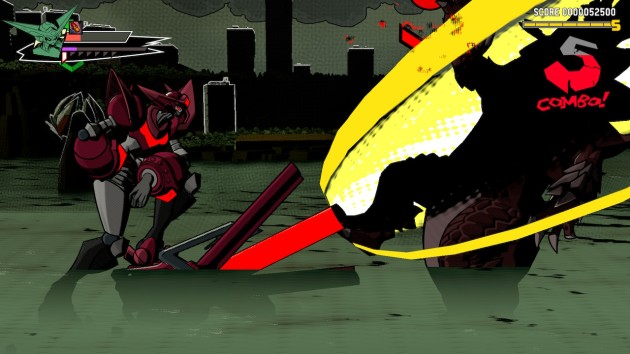
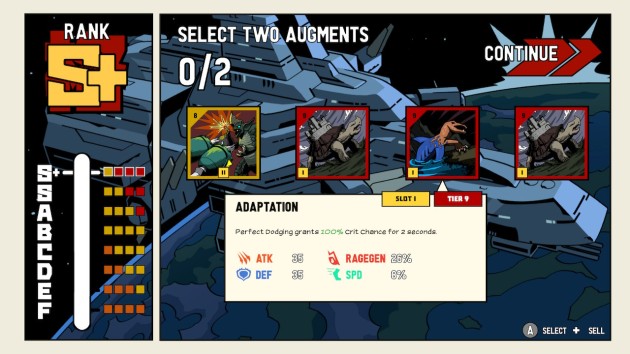
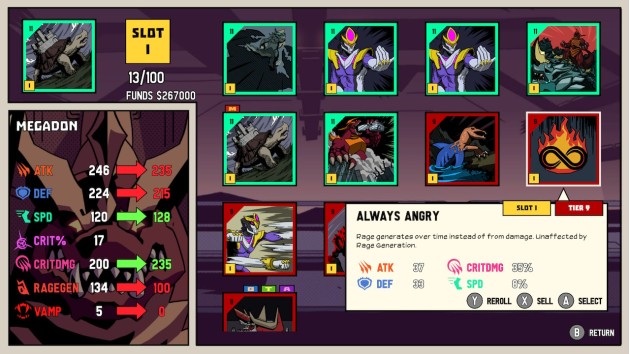

 Dawn of the Monsters is Chick-Approved
Dawn of the Monsters is Chick-Approved Dawn of the Monsters was developed by 13AM Games
Dawn of the Monsters was developed by 13AM Games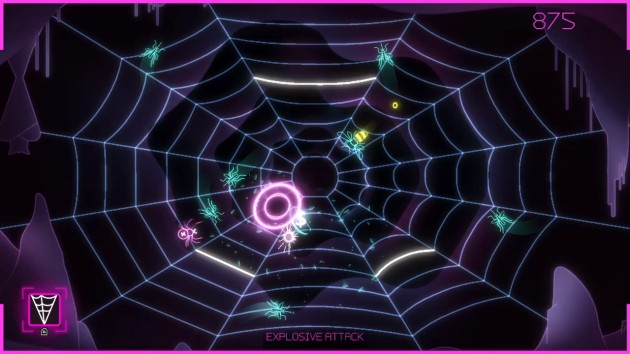
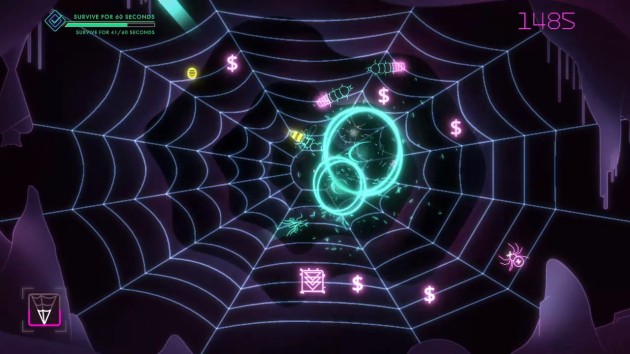
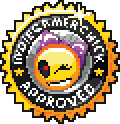 Black Widow Recharged is Chick-Approved
Black Widow Recharged is Chick-Approved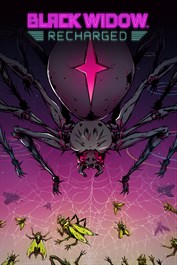 Black Widow: Recharged was developed by Adamvision Games (Published by Atari)
Black Widow: Recharged was developed by Adamvision Games (Published by Atari)
You must be logged in to post a comment.